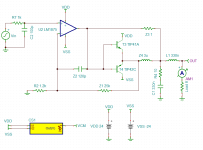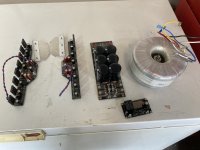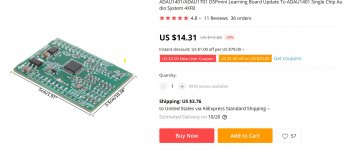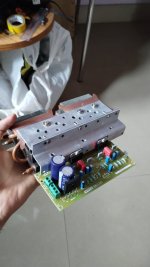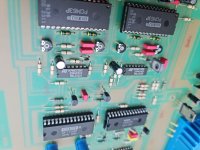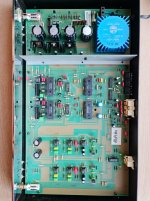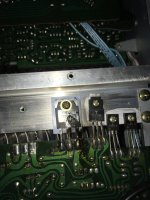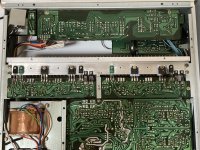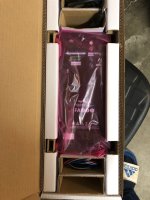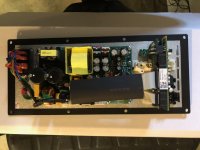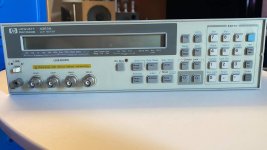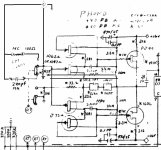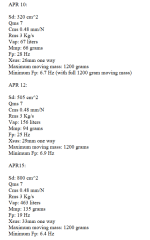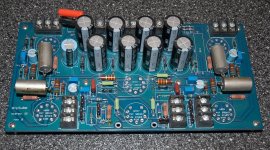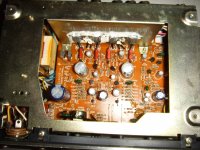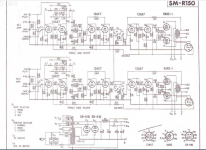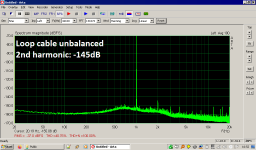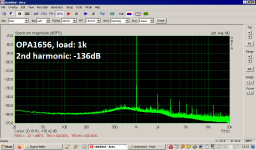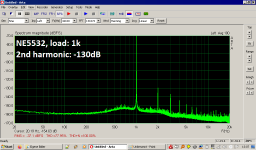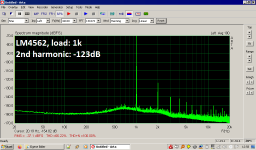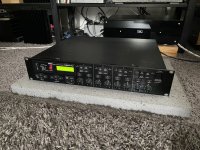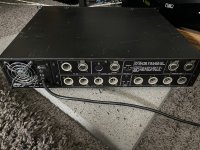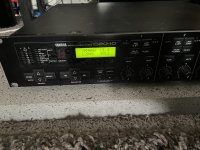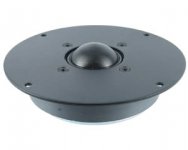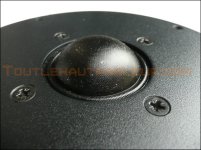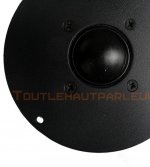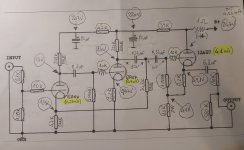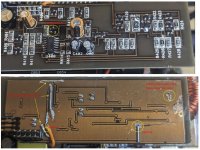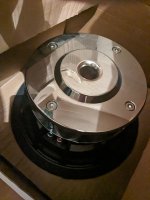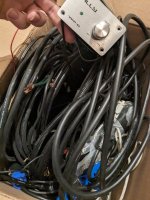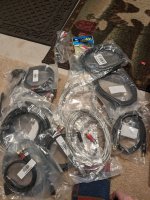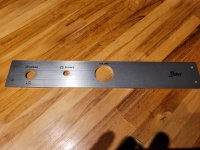You are using an out of date browser. It may not display this or other websites correctly.
You should upgrade or use an alternative browser.
You should upgrade or use an alternative browser.
Filters
Show only:
GOTO 6-way TimeAligned Horn System
- Multi-Way
- 463 Replies
I want to share my project here, because I believe that this experience can be interesting and I hope to have some feedback, comments, ideas and concerns regarding system I'm building and hopefully answers to my questions. I'm new to horns, so I have a lot to learn and all comments and suggestions are highly appreciated. But most importantly, I hope to get new audiophile friends around the international community 🙂 I had already thread at goodsoundclub, but failed to break through arrogance of Romy (we all know Romy 🙂) It was productive experience anyway...I learned a lot. And as you can see, eventually my system is Macondo-like.
During last 5 years I have thread at SoundEx (Russian audiophile community) and my system is actually a result of our joint work. Someone helped me with modeling, someone with measurements, someone lend me drivers for evaluation. And of course I had a lot of opinions and suggestions what to do next and were to go! So, this is truly our audiophiles community project! My personal role in this project is audio expertise! I'm listening and evaluating is this idea works or we need to search for another.
I have started with my first 3 way horn system around a year ago. It was hand built by one of the very respectable DIYer in Russia. I was impressed with the horn sound and from that moment I'm never returning to conventional speakers. Dynamic of horns is on another level. And I realized that for me this aspect is crucial. And first time in my life I found out that I can change sound for my taste by adjusting crossovers and changing drivers, so I started!
Before, the only option I had, was to buy speakers...what a boring thing...never happy. Now I can't imagine that I'm buying speaker, because for sure I want something to change for my expectation of sound. So, the only option I have from now and forever - do it yourself. That is why I'm here 🙂
With 5 years extensive experience with the best HighEnd systems and with the fact that I'm listening only classical (mostly piano concertos) and very often visit concert halls, I have very precise vision of what sound I want to get. If someone asks me to evaluate his system, I always ask to put some piano concertos, because otherwise I have no idea how it should sound. And with my first horn system I was quite happy with mid-range, but wanted more extended highs and I found out that there is some gap between MF and HF channel. So my first challenge was to find right HF driver.
Without budget limits I've tried a lot. Look at this picture:
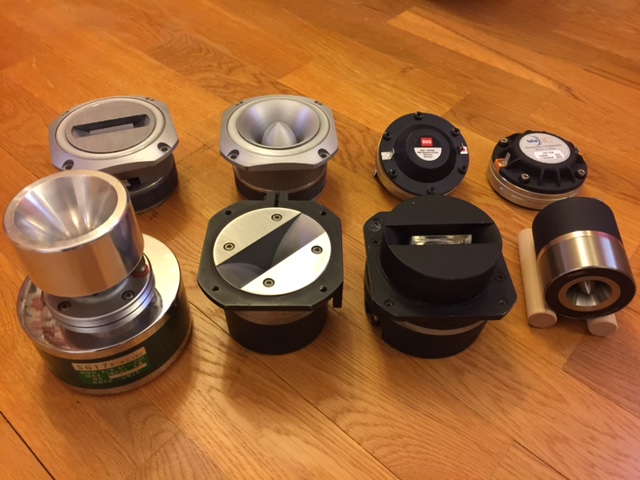
After all experiments, I realized, that I can't cover HF with this kind of 4-6kHz+ driver. JBL LE85 1" throat in 1000Hz horn was better than any of them and I compared and liked it more than TAD2001, so JBL got my credibility and I've ordered 2 latest JBL's: JBL 2453 and JBL D2430K D2.
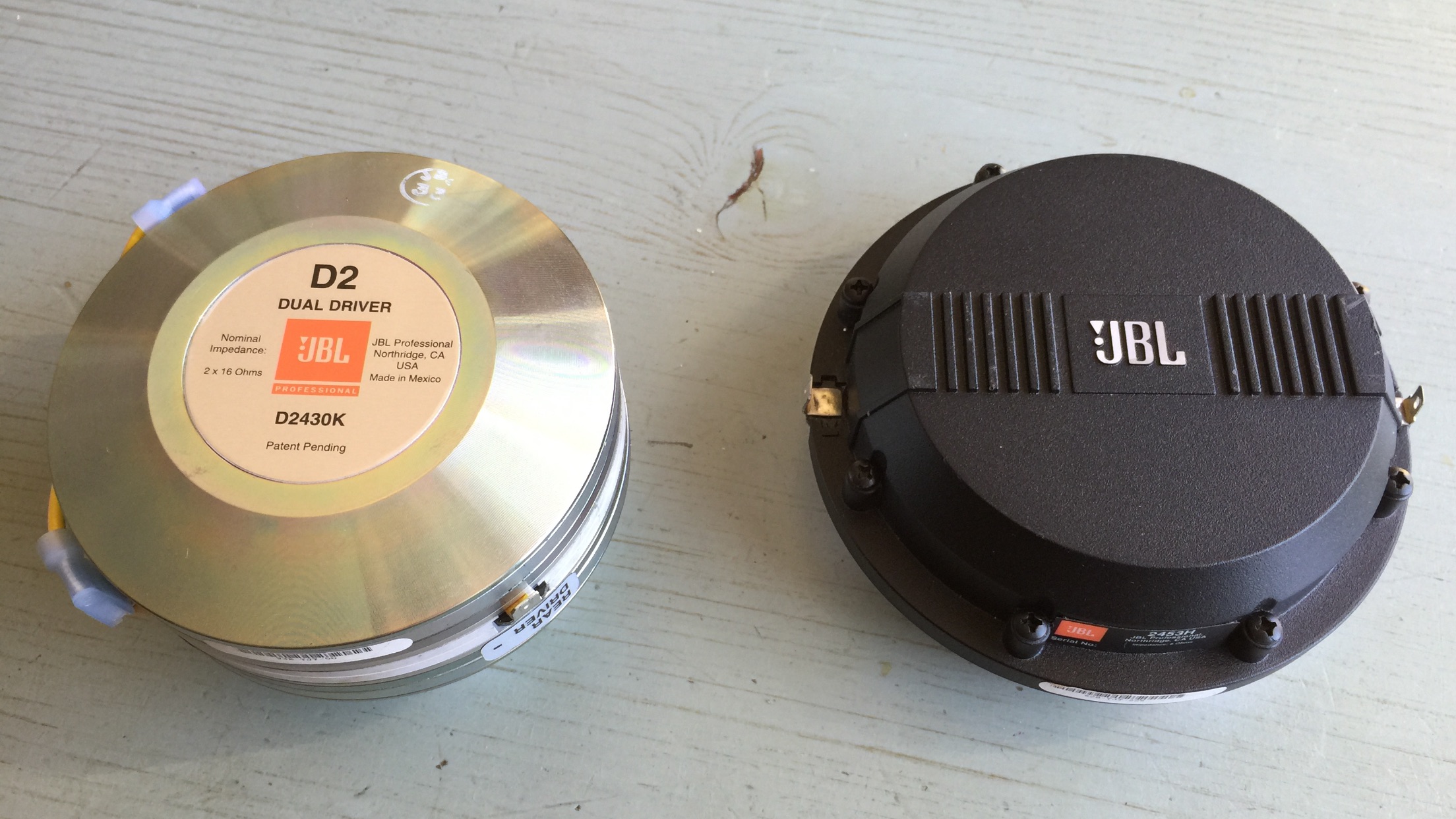
And I fall in love with JBL2453 in 550hz LeCleac'h Azura horn. It works perfectly for me in 1200-14k range.
After HighEnd exhibition in Munich 2015 my best system definitely was VOX Olympian Living Voice. But highest frequencies where better in Siltech room with their small bookshelf speakers with diamond Seas tweeter. So, I've decided that I need non-horn driver on top of my lovely JBL2453. From goodsoundclub I knew about RAAL Lazy Ribbon 9" and actually this is the only driver in the world which can match with horns with sensitivity. 111db! Even this was not enough and RAAL made special version for me with up to 115.5db! I'm waiting for it and now using another amp to match with sensitivity.
So, I've decided for myself, that JBL2453+RAAL is what I want on HF.
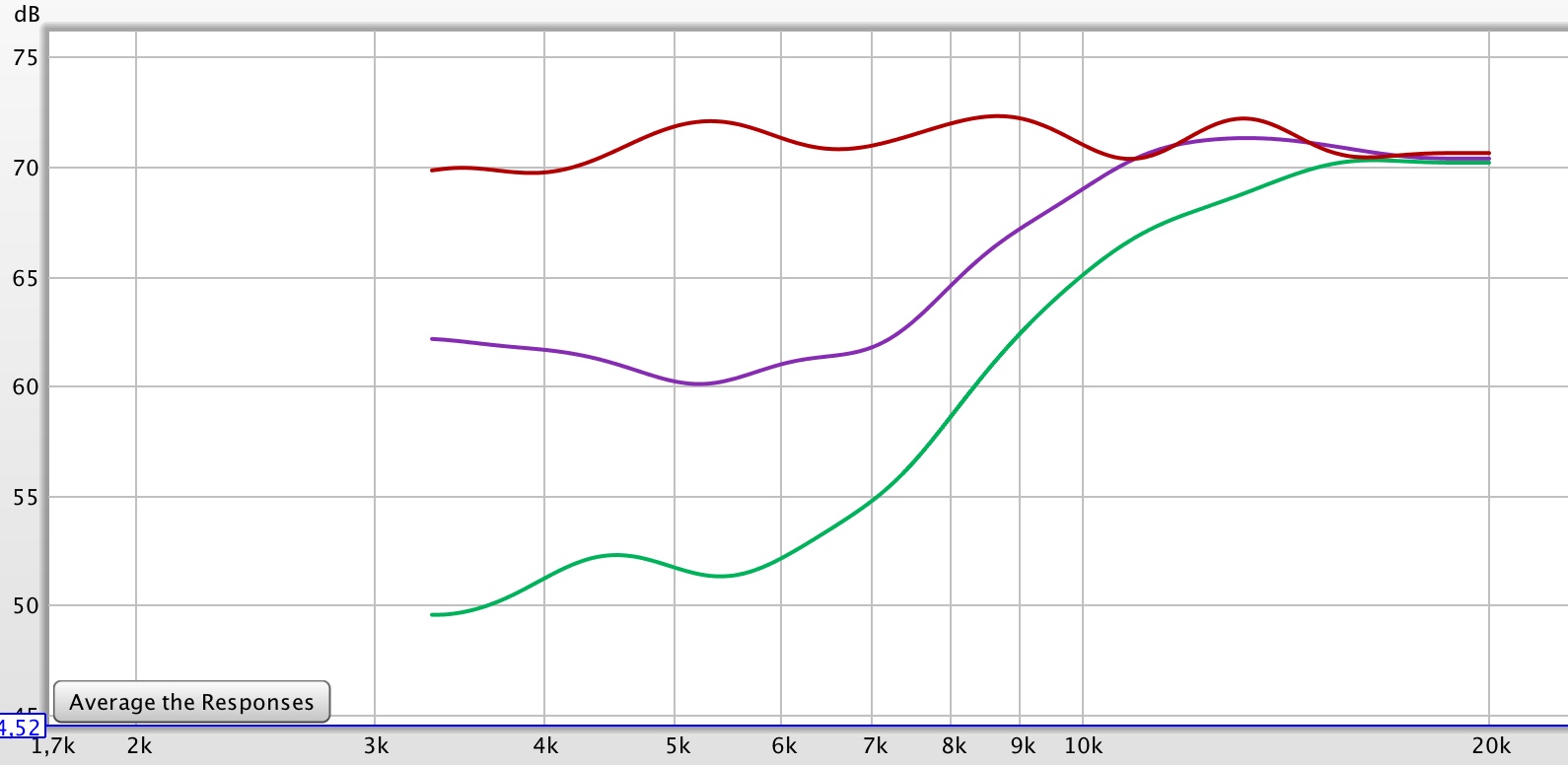
Blue - RAAL without filter
Green - RAAL with 3uf capacitor
Red - JBL2453 with RAAL
Next challenge was bass! Remember, that I was happy with MF, but my MF was 2m long folded horn. During experiments with Dirac (room correction) I realized how important is time-alignment. So, my idea was to unfold MF horn and design complementary 2m long bass horn!
I choose 11" Supravox 285-2000EXC and we created a model of perfect 46Hz horn with flat response from 70hz to 300Hz.
Here it is...big, ah? 🙂
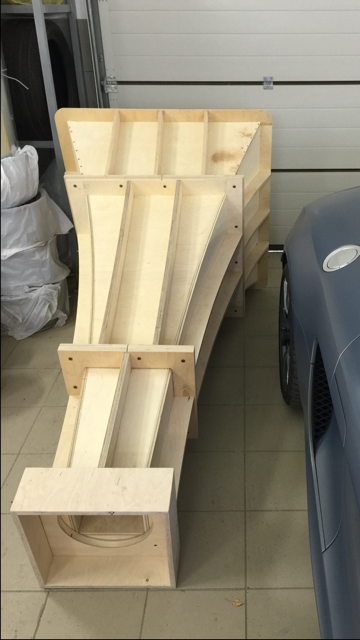
Real measurements were also perfect! Exactly as it was modeled in 3D acoustic research modeling software (3dar.ru) developed by my audiophile friend. And sound was very good. So, I was really happy with result.
But next day, by accident, I got two pairs of incredible bass drivers...GOTO SG-146LD!
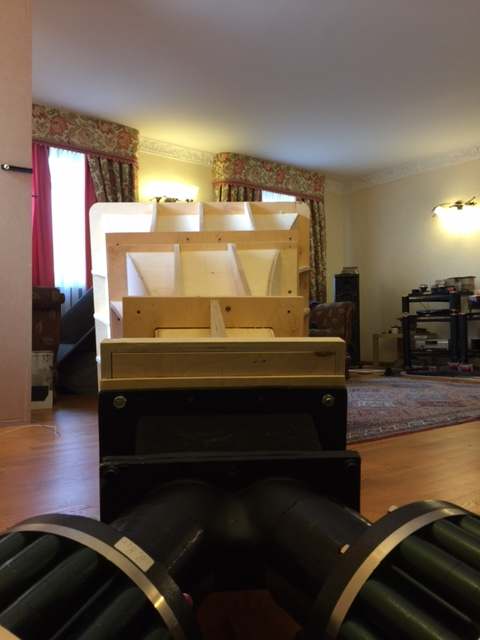
This drivers are truly game changers! First time in my life I heard right bass! Right bass is complete absence of bass in typical imagination, but very realistic reproduction of lowest octaves of piano and other instruments. It is pure as highs! No any artificial boom sound. Just pure tone of instruments. This is what I got from GOTO bass drivers in MidBass 46Hz horn. But I heard coloration in upper bass and measurements showed some fault. Look at this:

Blue - 11" Supravox in 46Hz horn
Green - GOTO 146 in 46Hz horn
Measurement shows that Supravox is preferable, but subjective listening experience gives no chance to Supravox. GOTO is pure and delicate while Supravox is bold and dirty boom like sound in contrast.
So, I've decided to use GOTO in 46Hz mid bass and introduce another channel - upper bass!
Here I must thanks to Romy as he rised concerns about using GOTO for upper bass. Fs of GOTO is very low (27Hz as I remember) and his believe is that Fs must be close to horn frequency. There is a way to tune Fs - changing volume of back chamber. And luckily GOTO has this option! Look at the back of it:
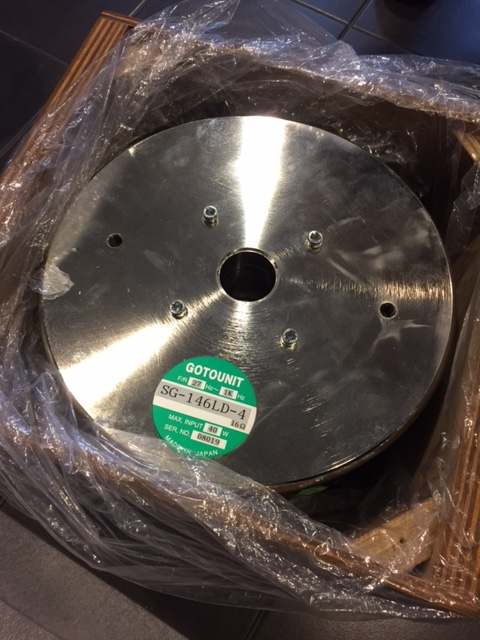
Here is an open hole in back chamber. I've closed it and got absolutely different response in upper bass horn:
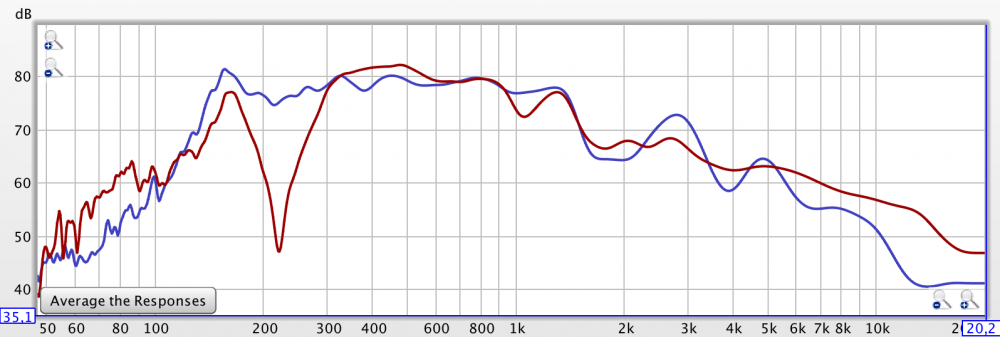
Red - GOTO in 200Hz LeCleac'h with opened back chamber's hole;
Blue - GOTO with closed back chamber.
So, I got 55-150hz in 46hz mid bass horn with opened back chamber's hole and 150+hz in 200Hz LeCleac'h horn made by Lukasz from Auto-Tech with closed back chamber. Clever, I think 🙂
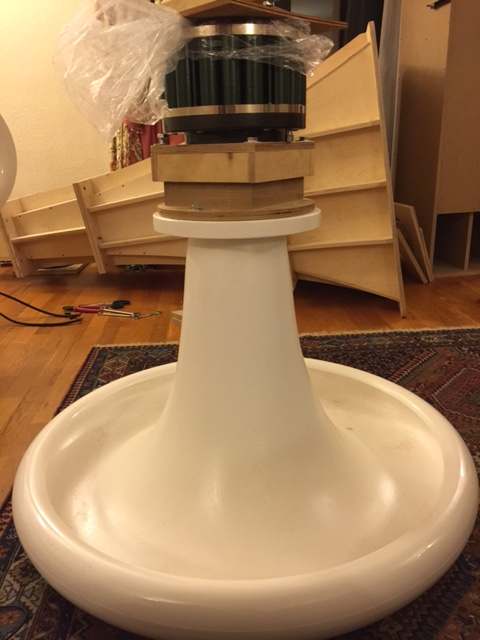
There is also interesting story about choosing upper bass horn to work from 150Hz. I compared 110Hz Tractrix with 200Hz LeCleac'h in HornResp and decided to use 200Hz LeCleac'h and I'm happy with result! LeCleac'h's "curl" extends lows and SPL is more flat! Subjective listening also confirmed that 200Hz LeCleac'h sounds great from 150hz!
Look again at measurements above: 150hz from 200hz LeCleac'h and my first question is: can someone explain this ?
So, at this stage my system is:
RAAL Lazy Ribbon 9" from 14khz
JBL2453 in 550Hz LeCleac'h from 1200hz
GOTO SG-146LD with closed back chamber in 200Hz LeCleac'h from 150Hz
GOTO SG-146LD with opened back chamber's hole in 46Hz horn
As you see from SPL above, GOTO in upperBass horn works well till 1200hz from which I have JBL2453. So, looks like I don't need MF channel. But I heard coloration again. To get comfortable sound I need to reduce the level of upperbass and that means that something wrong with it. So, it was obvious that I need MF channel. And MF channel was also a challenge.
As you remember, I told that I was happy with MF channel I had, but it is because I never heard anything better. It was K-55 replica from AtlasSound in custom 200Hz exponential 2m long folded horn. After discovering LeCleac'h I've decided that it will be LeCleac'h and created some vision of my hole system:
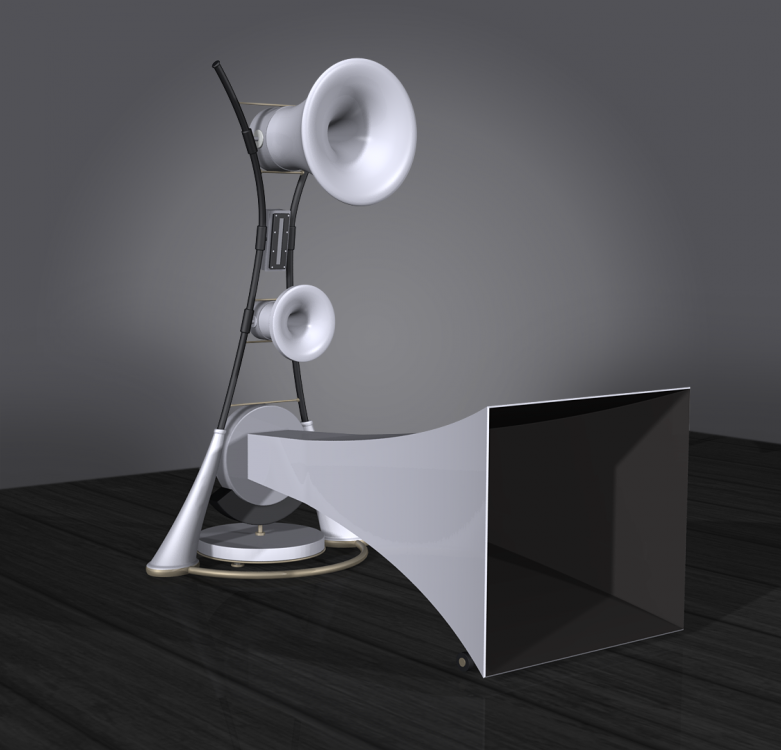
But this was before I got GOTO. So you see 2m bass horn at bottom and 270Hz LeCleac'h on top. The problem with MF was to find driver capable to work effectively in 270Hz horn from 350Hz because my 2m long 46hz works till 300Hz only. So, I got:
JBL 2490
JBL CMCD
JBL 2450
Vitavox S2
Supravox 8" 215-2000EXC
LM WE555
GOTO SG-555
With all this choice I was never happy with MF before I got SG-555. With SG-555 I got very pure tone and cut upperBass horn earlier. I'm still going to experiment with crossover and I'm still waiting for my 270Hz LeCleac'h horn. Now I'm using 350Hz spherical horn from Germany.
So, I got 5 ways and with ULF (lower than 55Hz) - 6 ways. And you see, that there is no other choice! Only 6-ways! I've explained in details why I have 6 ways. If you want to get pure open sound from horns without any coloration, than it is 6 ways!
The problem I have now is how to put all this 5 channels together (ULF is separate - is ok, I believe). Here are some renders of some ideas:
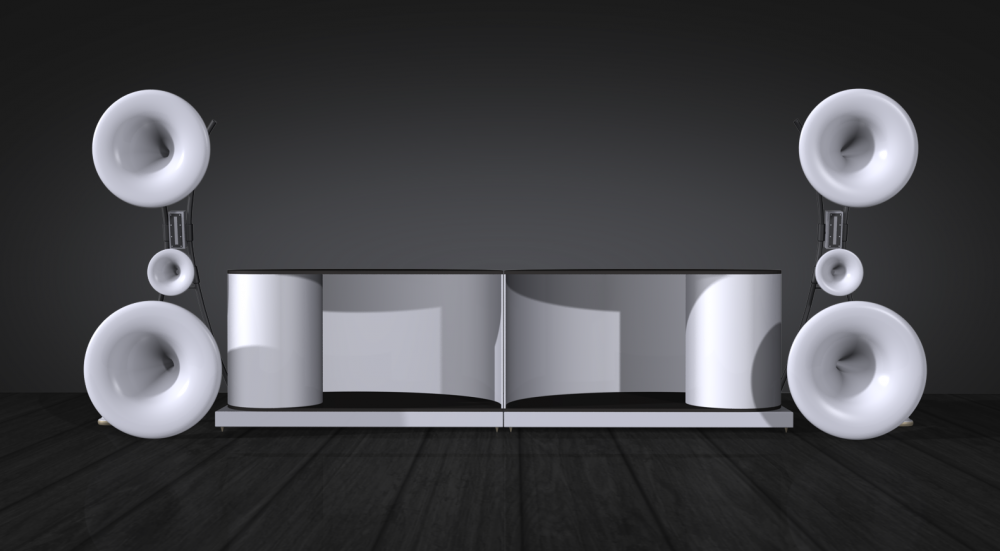
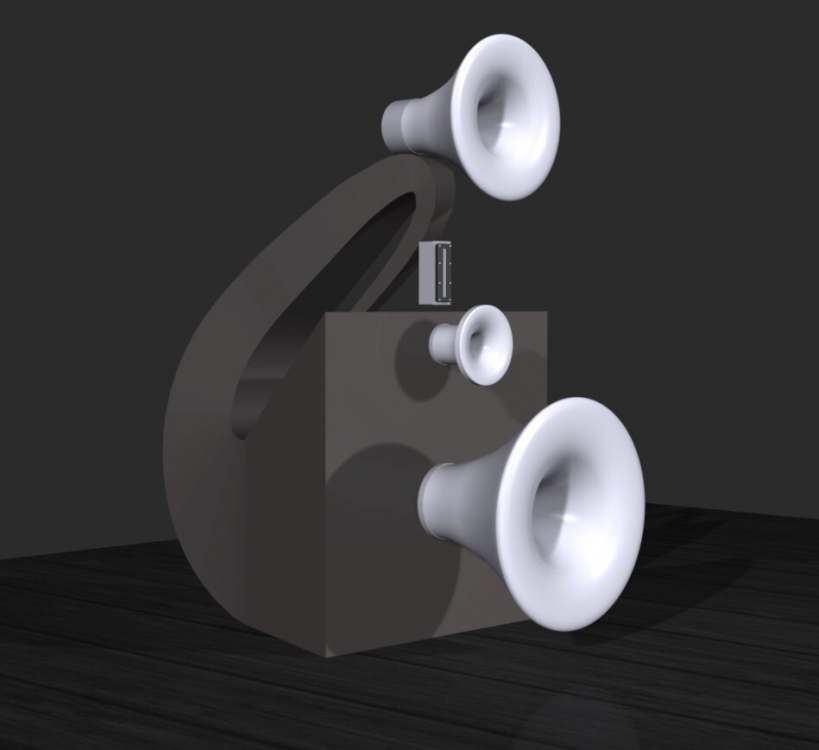
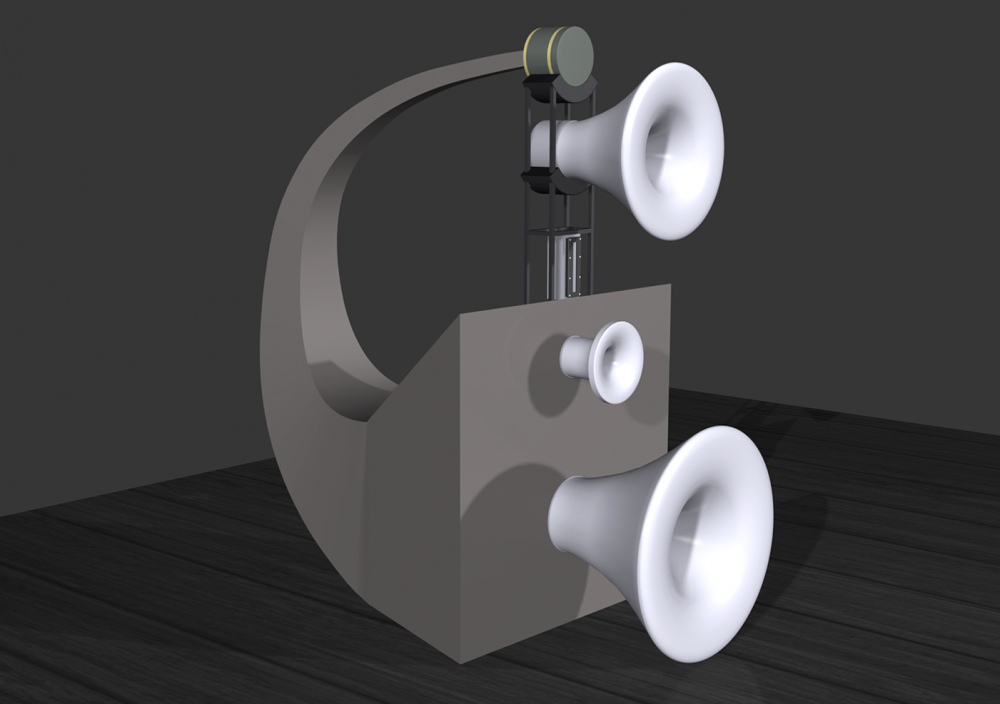
Not very elegant...so, for now, I think to separate mid-bass horn and put it at the back of listening sofa. In this case it will be time-aligned and I can keep 4 channels in front quite elegant.
At the end, I want to post some videos.
http://youtu.be/yd-Ra5qTVkE
http://youtu.be/aX3Nh0Z8Ucw
http://youtu.be/1hNo6Vz7zYc
http://youtu.be/7ougp0NaU7w
If someone has experience in evaluation of system sound through YouTube, than you can post your opinions, if not, than you can get some visual impression of what is going on. MF is still on the floor as frame is not ready. But very soon, I'll combine all together.
Again, I'll be very happy for any comments. I hope that my project is interesting for diyaudio community.
Murat.
During last 5 years I have thread at SoundEx (Russian audiophile community) and my system is actually a result of our joint work. Someone helped me with modeling, someone with measurements, someone lend me drivers for evaluation. And of course I had a lot of opinions and suggestions what to do next and were to go! So, this is truly our audiophiles community project! My personal role in this project is audio expertise! I'm listening and evaluating is this idea works or we need to search for another.
I have started with my first 3 way horn system around a year ago. It was hand built by one of the very respectable DIYer in Russia. I was impressed with the horn sound and from that moment I'm never returning to conventional speakers. Dynamic of horns is on another level. And I realized that for me this aspect is crucial. And first time in my life I found out that I can change sound for my taste by adjusting crossovers and changing drivers, so I started!
Before, the only option I had, was to buy speakers...what a boring thing...never happy. Now I can't imagine that I'm buying speaker, because for sure I want something to change for my expectation of sound. So, the only option I have from now and forever - do it yourself. That is why I'm here 🙂
With 5 years extensive experience with the best HighEnd systems and with the fact that I'm listening only classical (mostly piano concertos) and very often visit concert halls, I have very precise vision of what sound I want to get. If someone asks me to evaluate his system, I always ask to put some piano concertos, because otherwise I have no idea how it should sound. And with my first horn system I was quite happy with mid-range, but wanted more extended highs and I found out that there is some gap between MF and HF channel. So my first challenge was to find right HF driver.
Without budget limits I've tried a lot. Look at this picture:

After all experiments, I realized, that I can't cover HF with this kind of 4-6kHz+ driver. JBL LE85 1" throat in 1000Hz horn was better than any of them and I compared and liked it more than TAD2001, so JBL got my credibility and I've ordered 2 latest JBL's: JBL 2453 and JBL D2430K D2.

And I fall in love with JBL2453 in 550hz LeCleac'h Azura horn. It works perfectly for me in 1200-14k range.
After HighEnd exhibition in Munich 2015 my best system definitely was VOX Olympian Living Voice. But highest frequencies where better in Siltech room with their small bookshelf speakers with diamond Seas tweeter. So, I've decided that I need non-horn driver on top of my lovely JBL2453. From goodsoundclub I knew about RAAL Lazy Ribbon 9" and actually this is the only driver in the world which can match with horns with sensitivity. 111db! Even this was not enough and RAAL made special version for me with up to 115.5db! I'm waiting for it and now using another amp to match with sensitivity.
So, I've decided for myself, that JBL2453+RAAL is what I want on HF.

Blue - RAAL without filter
Green - RAAL with 3uf capacitor
Red - JBL2453 with RAAL
Next challenge was bass! Remember, that I was happy with MF, but my MF was 2m long folded horn. During experiments with Dirac (room correction) I realized how important is time-alignment. So, my idea was to unfold MF horn and design complementary 2m long bass horn!
I choose 11" Supravox 285-2000EXC and we created a model of perfect 46Hz horn with flat response from 70hz to 300Hz.
Here it is...big, ah? 🙂

Real measurements were also perfect! Exactly as it was modeled in 3D acoustic research modeling software (3dar.ru) developed by my audiophile friend. And sound was very good. So, I was really happy with result.
But next day, by accident, I got two pairs of incredible bass drivers...GOTO SG-146LD!
This drivers are truly game changers! First time in my life I heard right bass! Right bass is complete absence of bass in typical imagination, but very realistic reproduction of lowest octaves of piano and other instruments. It is pure as highs! No any artificial boom sound. Just pure tone of instruments. This is what I got from GOTO bass drivers in MidBass 46Hz horn. But I heard coloration in upper bass and measurements showed some fault. Look at this:

Blue - 11" Supravox in 46Hz horn
Green - GOTO 146 in 46Hz horn
Measurement shows that Supravox is preferable, but subjective listening experience gives no chance to Supravox. GOTO is pure and delicate while Supravox is bold and dirty boom like sound in contrast.
So, I've decided to use GOTO in 46Hz mid bass and introduce another channel - upper bass!
Here I must thanks to Romy as he rised concerns about using GOTO for upper bass. Fs of GOTO is very low (27Hz as I remember) and his believe is that Fs must be close to horn frequency. There is a way to tune Fs - changing volume of back chamber. And luckily GOTO has this option! Look at the back of it:

Here is an open hole in back chamber. I've closed it and got absolutely different response in upper bass horn:

Red - GOTO in 200Hz LeCleac'h with opened back chamber's hole;
Blue - GOTO with closed back chamber.
So, I got 55-150hz in 46hz mid bass horn with opened back chamber's hole and 150+hz in 200Hz LeCleac'h horn made by Lukasz from Auto-Tech with closed back chamber. Clever, I think 🙂

There is also interesting story about choosing upper bass horn to work from 150Hz. I compared 110Hz Tractrix with 200Hz LeCleac'h in HornResp and decided to use 200Hz LeCleac'h and I'm happy with result! LeCleac'h's "curl" extends lows and SPL is more flat! Subjective listening also confirmed that 200Hz LeCleac'h sounds great from 150hz!
Look again at measurements above: 150hz from 200hz LeCleac'h and my first question is: can someone explain this ?
So, at this stage my system is:
RAAL Lazy Ribbon 9" from 14khz
JBL2453 in 550Hz LeCleac'h from 1200hz
GOTO SG-146LD with closed back chamber in 200Hz LeCleac'h from 150Hz
GOTO SG-146LD with opened back chamber's hole in 46Hz horn
As you see from SPL above, GOTO in upperBass horn works well till 1200hz from which I have JBL2453. So, looks like I don't need MF channel. But I heard coloration again. To get comfortable sound I need to reduce the level of upperbass and that means that something wrong with it. So, it was obvious that I need MF channel. And MF channel was also a challenge.
As you remember, I told that I was happy with MF channel I had, but it is because I never heard anything better. It was K-55 replica from AtlasSound in custom 200Hz exponential 2m long folded horn. After discovering LeCleac'h I've decided that it will be LeCleac'h and created some vision of my hole system:

But this was before I got GOTO. So you see 2m bass horn at bottom and 270Hz LeCleac'h on top. The problem with MF was to find driver capable to work effectively in 270Hz horn from 350Hz because my 2m long 46hz works till 300Hz only. So, I got:
JBL 2490
JBL CMCD
JBL 2450
Vitavox S2
Supravox 8" 215-2000EXC
LM WE555
GOTO SG-555
With all this choice I was never happy with MF before I got SG-555. With SG-555 I got very pure tone and cut upperBass horn earlier. I'm still going to experiment with crossover and I'm still waiting for my 270Hz LeCleac'h horn. Now I'm using 350Hz spherical horn from Germany.
So, I got 5 ways and with ULF (lower than 55Hz) - 6 ways. And you see, that there is no other choice! Only 6-ways! I've explained in details why I have 6 ways. If you want to get pure open sound from horns without any coloration, than it is 6 ways!
The problem I have now is how to put all this 5 channels together (ULF is separate - is ok, I believe). Here are some renders of some ideas:



Not very elegant...so, for now, I think to separate mid-bass horn and put it at the back of listening sofa. In this case it will be time-aligned and I can keep 4 channels in front quite elegant.
At the end, I want to post some videos.
http://youtu.be/yd-Ra5qTVkE
http://youtu.be/aX3Nh0Z8Ucw
http://youtu.be/1hNo6Vz7zYc
http://youtu.be/7ougp0NaU7w
If someone has experience in evaluation of system sound through YouTube, than you can post your opinions, if not, than you can get some visual impression of what is going on. MF is still on the floor as frame is not ready. But very soon, I'll combine all together.
Again, I'll be very happy for any comments. I hope that my project is interesting for diyaudio community.
Murat.
Can I wire two mono microphones to a 3,5mm stereo jack?
- By Arne Jensen
- Instruments and Amps
- 12 Replies
Hello,
My mum is looking for a mic for her podcast and since I have 2 mono microphones (Uher m534) and she is doing the podcast with a partner I thought
it might be neat to use them together via stereo jack so there is a slight stereo effect. Her laptop only has one mic input so it would be convenient if it worked. Is this possible or will it result in a pop noise , possibly some smoke and followed by silence ?
Thanks for your help!
Arne
My mum is looking for a mic for her podcast and since I have 2 mono microphones (Uher m534) and she is doing the podcast with a partner I thought
it might be neat to use them together via stereo jack so there is a slight stereo effect. Her laptop only has one mic input so it would be convenient if it worked. Is this possible or will it result in a pop noise , possibly some smoke and followed by silence ?
Thanks for your help!
Arne
IRS2092S based DIY amp
- By MJC147
- Solid State
- 3 Replies
hello, im trying to build a relatively low cost amplifier for my 500w 4ohm subwoofer. so far Ive managed to get everything working (playing relatively loud & clear) however I would love some clarification on a few things.

A) I don't know if I'm correct, but I believe I need to isolate the power going to each SMPS, at the moment i have one SMPS connected to a socket in my room, and the other SMPS is connected to a different socket. i measured the resistance between each of the 12v outputs on the SMPS and it was over 2 Mohm so this is a good way of isolating them, however would having them both on the same AC line work? maybe they have some sort of isolation built in...
Here's the SMPS product link: here
B) I have seen quite a lot of videos that say these little step-ups cannot reach 500w ( playing loud for a while), is this true? they use TL494. Also lets say the IRS2092 draws 500w. would this be split between the two step-ups (250w drawing from each)? if so then i imagine they would be alright, I've never really seen "negative" voltage before so its kind of new to me the idea that ground is just a reference etc. step-up (it is 60v idk why it says 50v)
C)Note that i have added much larger heatsinks and fan cooling to all the parts. Is it possible that the IRS2092S could reach 500w at 4ohms? I am certain i have a legitimate IS2092 amp as it has the chip heatsink, proper mosfets and other signs.
Any other tips would really be appreciated, I'm on a bit of a tight budget and don't want to break what i already have, while still getting some nice performance.
irs2092s: here
A) I don't know if I'm correct, but I believe I need to isolate the power going to each SMPS, at the moment i have one SMPS connected to a socket in my room, and the other SMPS is connected to a different socket. i measured the resistance between each of the 12v outputs on the SMPS and it was over 2 Mohm so this is a good way of isolating them, however would having them both on the same AC line work? maybe they have some sort of isolation built in...
Here's the SMPS product link: here
B) I have seen quite a lot of videos that say these little step-ups cannot reach 500w ( playing loud for a while), is this true? they use TL494. Also lets say the IRS2092 draws 500w. would this be split between the two step-ups (250w drawing from each)? if so then i imagine they would be alright, I've never really seen "negative" voltage before so its kind of new to me the idea that ground is just a reference etc. step-up (it is 60v idk why it says 50v)
C)Note that i have added much larger heatsinks and fan cooling to all the parts. Is it possible that the IRS2092S could reach 500w at 4ohms? I am certain i have a legitimate IS2092 amp as it has the chip heatsink, proper mosfets and other signs.
Any other tips would really be appreciated, I'm on a bit of a tight budget and don't want to break what i already have, while still getting some nice performance.
irs2092s: here
Refoam help for some old EV Sentry drivers
- By Zwiller
- Subwoofers
- 1 Replies
Never did this before. Seems pretty basic but would love any help from the gurus here. Any thoughts or guidance appreciated.
Tube Amp+MiniDSP+OpenBaffle
- By CharlesArm
- Tubes / Valves
- 11 Replies
Hi, I need your help. There are many posts but still I don't know anything.
I have a 300B Stereo tube amplifier and OpenBaffle 2-way speakers.
Can I use minidsp with this amplifier?
Drivers are Lii F18 and SB Audience 18sw450.
Does it need more than just a dsp module?
I have a 300B Stereo tube amplifier and OpenBaffle 2-way speakers.
Can I use minidsp with this amplifier?
Drivers are Lii F18 and SB Audience 18sw450.
Does it need more than just a dsp module?
More SPL / weird phase vs less spl / common phase Question? Which is better?
- Subwoofers
- 1 Replies
I've been staring at this WinISD graph for two hours now and I have to make a choice and I don't really know which answer is the right answer.
1. Do I add in the mix a subwoofer that produces more SPL (Devastator)?
or
2. Do I pick the box that conforms more to other boxes in the phase category (sealed)?
And why?
First let me start out by saying that I already have 6-Pa460 in sealed boxes (RED) and 2-Fi audio 15Vx3's in sealed boxes (PINK). Now, I know Staying with all the same alignments has its benefits..... but so does gaining a lot of SPL and past that I really don't see too much of a difference in the other categories like power consumption or excursion which is all in check. I should be able to to get to a reasonable SPL level regardless of which choice I make also, I'm not trying to or need to shake my house apart, just need a reasonable movie level....and maybe a little extra.
So, BLUE and PURPLE are 8-JBL1240 Drivers.... one choice is all 8 sealed (BLUE) """OR""" all 8 in Devastator boxes (PURPLE) 6th order bandpass. Oh, and I have a minidsp2x4HD and a umik1 mic already, I'm not new around here.
Crossovers are set like this-
2-15Vx3's - 2nd order BW at 10Hz with 3000w - 8 cuft
6-Pa460's - 2nd order BW at 15Hz with 1500w - 20 cuft
8-JBL sealed - 2nd order BW at 10 HZ with 2000w -16 cuft
8 JBL Devastators 2n order BW at 18Hz with 2400w
Here is all sealed


Here is the group delay for all of them

And here is sealed with the Devastators


1. Do I add in the mix a subwoofer that produces more SPL (Devastator)?
or
2. Do I pick the box that conforms more to other boxes in the phase category (sealed)?
And why?
First let me start out by saying that I already have 6-Pa460 in sealed boxes (RED) and 2-Fi audio 15Vx3's in sealed boxes (PINK). Now, I know Staying with all the same alignments has its benefits..... but so does gaining a lot of SPL and past that I really don't see too much of a difference in the other categories like power consumption or excursion which is all in check. I should be able to to get to a reasonable SPL level regardless of which choice I make also, I'm not trying to or need to shake my house apart, just need a reasonable movie level....and maybe a little extra.
So, BLUE and PURPLE are 8-JBL1240 Drivers.... one choice is all 8 sealed (BLUE) """OR""" all 8 in Devastator boxes (PURPLE) 6th order bandpass. Oh, and I have a minidsp2x4HD and a umik1 mic already, I'm not new around here.
Crossovers are set like this-
2-15Vx3's - 2nd order BW at 10Hz with 3000w - 8 cuft
6-Pa460's - 2nd order BW at 15Hz with 1500w - 20 cuft
8-JBL sealed - 2nd order BW at 10 HZ with 2000w -16 cuft
8 JBL Devastators 2n order BW at 18Hz with 2400w
Here is all sealed


Here is the group delay for all of them

And here is sealed with the Devastators

Offset tweeter line array MTM layout
Hi,
Has anyone seen that drole layout : S300 MTM
If I can understand why it is usefull to make closer both woofers in order to a better center to center for higher frequency beginning of the honney comb effect, however I wonder about the fullly offseted tweeter in between as well as adding two tweeters for a tweeter array. Proac and Living voice offseted sligthy the tweeter in their MTMs but never as far as M&K Sound breaking the vertically mid to tweeter layout "rule"!
What if suppressing the two top and bottom tweeters ?
How can be horizontal response with such fully offsetted tweeter if all the centers to centers are not 1/4 WL but 1.5 WL due to the size of drivers and tweeter face plate ?
Thanks for your thougths
Has anyone seen that drole layout : S300 MTM
If I can understand why it is usefull to make closer both woofers in order to a better center to center for higher frequency beginning of the honney comb effect, however I wonder about the fullly offseted tweeter in between as well as adding two tweeters for a tweeter array. Proac and Living voice offseted sligthy the tweeter in their MTMs but never as far as M&K Sound breaking the vertically mid to tweeter layout "rule"!
What if suppressing the two top and bottom tweeters ?
How can be horizontal response with such fully offsetted tweeter if all the centers to centers are not 1/4 WL but 1.5 WL due to the size of drivers and tweeter face plate ?
Thanks for your thougths
“High gain” vacuum tubes?
- By SoaDMTGguy
- Parts
- 6 Replies
One of the tube options on tube depot is to select for “high gain”. How much gain viability could there realistically be between new production versions of the same tube model?
free PA drivers and casket
Hi,
got some good and blown PA drivers local pick up as shipping will be high. I am in San Diego 92105. Please PM




got some good and blown PA drivers local pick up as shipping will be high. I am in San Diego 92105. Please PM
Fostex FE103 Enclosure
- By aquapiranha
- Full Range
- 0 Replies
Hi! I used to own these speakers, and I really do miss them! Would anyone have any idea as to the origin of the RLH enclosure? I would love to recreate them thanks.
Steve

Steve
Holton Precision Audio NXV500 modules & power supply
- By wirewiggler
- Swap Meet
- 0 Replies
Holton Precison Audio NVX 500 amp modules, power supply board, and 1KV Sum R 2X55 V toroid transformer. These are working with low hours on them, I had thought the transformer had a buzz but it turned out to be the soft start module. In any case I will include the module and if you want to repair it it will need the small onboard power supply replaced. I removed these working from the case to reuse it for the Wolverine amp I am building.
Price is $350 + freight and PayPal fees.
Price is $350 + freight and PayPal fees.
Attachments
5C4M / 5Ц4М vs 5AR4 / GZ34
- By baldrick
- Tubes / Valves
- 1 Replies
Has anyone successfully swapped in a Russian / Soviet 5C4M / 5Ц4М rectifier in place of a 5AR4?
They claim that it is equivalent, and they're cheap as dirt right now compared to 5AR4/GZ34 which are starting to get ridiculous.
They claim that it is equivalent, and they're cheap as dirt right now compared to 5AR4/GZ34 which are starting to get ridiculous.
ADAU1401/ADAU1701 DSPmini Learning Board
- By bradleypnw
- Digital Line Level
- 13 Replies
Hi, I found this on Aliexpress and was wondering if it is a board that can be used to make active crossover speakers. If so, that would be pretty great rather than buying a MiniDSP for each speaker.
Description:
Description:
Features:
The ADAU1401 is a complete single-chip audio system with built-in 28/56-bit audio DSP, ADC, DAC and microcontroller-like control interface. Signal processing techniques including equalization, crossover, bass boost, multi-band dynamic processing, delay compensation, speaker compensation, and stereo image widening can be used to compensate for the practical limitations of speakers, amplifiers, and listening environments, dramatically improving the sound quality experience.
The ADAU1401 program can be loaded from the serial EEPROM through its self-booting mechanism at power-up or from an external microcontroller. When turned off, the current state of the parameter can be written back to the EEPROM from the ADAU1401 to be recalled the next time the program is run.
Two ADCs and four DACs provide 98.5 dB of analog input to analog output dynamic range. Seamless connection to other ADCs and DACs is possible with digital input and output ports. The ADAU1401 communicates over an I2C bus or a four-wire SPI port.
This edition is suitable for ADAU1401/1701/1702 learning and product use. The ADAU1401 is more stable than the ADAU1701 in the harsh working environment of -40°-105° (the ADAU1701 is generally 0-70°). The program can be used universally and other indicators are the same. It has self-starting after power-on and can be completely separated from the single-chip operation. Leads to all function ports, which can expand digital I2S input/output/key function/LED drive/auxiliary ADC (potentiometer analog)/encoder volume adjustment.
Application:
Multimedia speaker system
MP3 player speaker
Car audio host
Mini stereo system
Digital Television
Studio monitoring system
Speaker divider
Instrument sound processor
Seat sound system (aircraft / coach)
Specification:
Dimensions: 3.5x5cm/1.38x1.97inch
Color: Green
Quantity: 1 Pc
Note: 1.Please allow 0-1cm error due to manual measurement. pls make sure you do not mind before you bid.
2.Due to the difference between different monitors, the picture may not reflect the actual color of the item. Thank you!
Package includes:
1 x ADAU1401/ADAU1701 DSPmini Learning Board (without retail package)
Attachments
The Blameless CFP
- Solid State
- 22 Replies
D. Self has started designing his Blamless amp by using CFP output in 1993.
http://www.douglas-self.com/ampins/dipa/dipa.htm
Rode Elliot transformed the CCS into bootstrap to call it P3 and in 2007 the VAS got upside down with with PNP to be called P3a.
The P3a is highly appreciated for its sound the Sakis @east electronics who repairs over 1000 amps a year has never heard any amp as good.
Recently I could considerably enhanced the CFP output stage to be as good as a class A can be, so I will take back the aborted Blamless and design it for best sounding.
The P3a will be the starting point to start enhancing, as it is a tuned amplifier.
https://sound-au.com/project03.htm
It has an NFB of 58db up to 1khz, the harmonc distortion is even order dominant.
This is the circuit of the actual amp that will be regularly updated

The CFP output stage is elaborating on, https://www.diyaudio.com/community/...rossover-p3a-of-rod-elliot-as-example.402148/
http://www.douglas-self.com/ampins/dipa/dipa.htm
Rode Elliot transformed the CCS into bootstrap to call it P3 and in 2007 the VAS got upside down with with PNP to be called P3a.
The P3a is highly appreciated for its sound the Sakis @east electronics who repairs over 1000 amps a year has never heard any amp as good.
Recently I could considerably enhanced the CFP output stage to be as good as a class A can be, so I will take back the aborted Blamless and design it for best sounding.
The P3a will be the starting point to start enhancing, as it is a tuned amplifier.
https://sound-au.com/project03.htm
It has an NFB of 58db up to 1khz, the harmonc distortion is even order dominant.
This is the circuit of the actual amp that will be regularly updated
The CFP output stage is elaborating on, https://www.diyaudio.com/community/...rossover-p3a-of-rod-elliot-as-example.402148/
Newby question: Why are classic negative bias supplies so poorly filtered?
- By Windcrest77
- Tubes / Valves
- 29 Replies
In analyzing many direct grid-biased schematics from the 50's 60's and even now. (I'm talking classic amplifiers that have unregulated HT and unregulated bias so the HT and bias can both track any line voltage variations).
I noticed that the negative bias supply is very often just a half wave rectifier with a capacitor, followed by the divider and bias adjustment pot network. When I do come across something that does bother to use full wave rectification, there is still often no multi stage pi filtering. I found a few that capacitive couple the HT bridge with another bridge, then reference the cathode of that bridge to the HT negative then take the anode side of that bridge as the bias. In all these cases nobody seems to bother putting much filtering on the negative bias other than a C filter and maybe another C in the upper leg (HT neg side) of the voltage divider at the end...
Question: Why does the negative bias supply not require very much in the way of filtering? Is it because the current draw for a grid bias is so very very small that it's ripple gets swamped by the incoming signal? Should I bother to pi filter an unregulated bias supply like this with a couple of RC stages or not (probably not enough current flow to do that right)?
I noticed that the negative bias supply is very often just a half wave rectifier with a capacitor, followed by the divider and bias adjustment pot network. When I do come across something that does bother to use full wave rectification, there is still often no multi stage pi filtering. I found a few that capacitive couple the HT bridge with another bridge, then reference the cathode of that bridge to the HT negative then take the anode side of that bridge as the bias. In all these cases nobody seems to bother putting much filtering on the negative bias other than a C filter and maybe another C in the upper leg (HT neg side) of the voltage divider at the end...
Question: Why does the negative bias supply not require very much in the way of filtering? Is it because the current draw for a grid bias is so very very small that it's ripple gets swamped by the incoming signal? Should I bother to pi filter an unregulated bias supply like this with a couple of RC stages or not (probably not enough current flow to do that right)?
For Sale Marchand XM-1 Active Xover
Still cleaning out closets.
On offer is a working (or was, at least) Marchand XM-1 modular active 3 way crossover. I used it in a tri-amped setup that sounded quite good, but I gave up on the project when KISS Nelson Pass clones caught my attention.
Comes as pictured, PS is a very nice regulated example that was gleaned from a SCADA system that was being decommissioned back about 2008.
See also 2 extra XM-1 modules and some frequency determining resistor plug ins.
$88 Paypal +3%, or Friends and Family. Shipped USPS Priority, CONUS only.
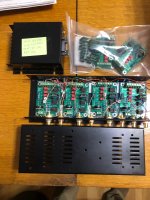
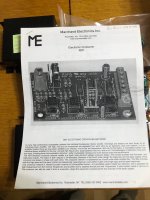
On offer is a working (or was, at least) Marchand XM-1 modular active 3 way crossover. I used it in a tri-amped setup that sounded quite good, but I gave up on the project when KISS Nelson Pass clones caught my attention.
Comes as pictured, PS is a very nice regulated example that was gleaned from a SCADA system that was being decommissioned back about 2008.
See also 2 extra XM-1 modules and some frequency determining resistor plug ins.
$88 Paypal +3%, or Friends and Family. Shipped USPS Priority, CONUS only.


VU Meter for multi-channel
- By ldarieut
- Analog Line Level
- 3 Replies
So, I have this multi channel amp I assembled from hypex modules, and power supplies.
I have regulated the Vaux from the hypex smps to a 12VDC to feed the VU Meter board from aliexpress.
Ncore are balanced output, so I have used alligator clips on one of the XLR out (Hot and ground) to the Vu Meter board line in + and ground.
Consequently, VU Meter is showing only the bandpassed audio signal (I made the parallel connection on the mid amplifier, 300Hz-1800Hz)
And, it sort of works, since the needle goes to about half the meter with the preamp at -30dB (which is already a bit too loud for my taste) and the LED is bright enough for me with the 220 Ohms resistor I added on the 4 led input.
Questions:
Pictures of the setup which looks a bit ghetto at the moment...

I have regulated the Vaux from the hypex smps to a 12VDC to feed the VU Meter board from aliexpress.
Ncore are balanced output, so I have used alligator clips on one of the XLR out (Hot and ground) to the Vu Meter board line in + and ground.
Consequently, VU Meter is showing only the bandpassed audio signal (I made the parallel connection on the mid amplifier, 300Hz-1800Hz)
And, it sort of works, since the needle goes to about half the meter with the preamp at -30dB (which is already a bit too loud for my taste) and the LED is bright enough for me with the 220 Ohms resistor I added on the 4 led input.
Questions:
- is this setup somehow degrading the sound signal considering the parallel wiring & the board used? From what I read, it shouldn't.
- what should I do if I want to show the whole band on the VU? Connecting the three XLR hot and XLR gnd to the vu board in parallel? Is this advisable? is there another option?
Pictures of the setup which looks a bit ghetto at the moment...
2-way & 3-way Exotic Loudspeaker Design Ideas
- Multi-Way
- 16 Replies
Hi Guys! 
I am planning to design, make, sell 2-way and/or 3-way "exotic" speakers. I already have some ideas but I want to ask for your opinion about them. And I also appreciate any other "exotic" 2-way/3-way ideas which is creative. 🙂
Only my first idea is ready, here it is:
What are your thoughts of my idea?
Would you change something in it?(size, drivers, amp, etc.)
Have a better "exotic" idea?
Please let me know here! 🙂
_______________________________
Have a nice day,
Alie-n Sound Systems - Martin
_______________________________
Remember: The design will be selected and made according to Your feedback, this will be a product what you can buy anywhere in the world! So this will be the eternal power of the community! 😎
So this will be the eternal power of the community! 😎

I am planning to design, make, sell 2-way and/or 3-way "exotic" speakers. I already have some ideas but I want to ask for your opinion about them. And I also appreciate any other "exotic" 2-way/3-way ideas which is creative. 🙂
Only my first idea is ready, here it is:
- Basically it would be an active 2-way sealed speaker with an AMD Motherboard (AsRock B550M-ITX/ac) built in it.
- It would contain a 6.5" subwoofer and a 6.5" mid-bass with a tweeter (in its middle) -- The Speakers would be a Dayton and SB Acoustics (or Thunder Germany)
- The amp would be a self-made board using the TPA3255 and the ADAU1701 DSP
- The size of the speaker would be: height of 40cm ; width of 20cm ; depth of 30cm (or 40cm, depends on your feedback)
What are your thoughts of my idea?
Would you change something in it?(size, drivers, amp, etc.)
Have a better "exotic" idea?
Please let me know here! 🙂
_______________________________
Have a nice day,
Alie-n Sound Systems - Martin
_______________________________
Remember: The design will be selected and made according to Your feedback, this will be a product what you can buy anywhere in the world!
 So this will be the eternal power of the community! 😎
So this will be the eternal power of the community! 😎At last: the ultimate, science-proven audiophile-grade cable is available
- By Elvee
- The Lounge
- 15 Replies
Have your credit-card ready, it's there:
https://www.sciencedaily.com/releases/2023/09/230921154505.htm
https://www.sciencedaily.com/releases/2023/09/230921154505.htm
TDA7294
- By varuncool
- Solid State
- 26 Replies
Hello guys i made a new amplifier of tda7294 x2 channel (100 watt per channel). In the beginning I was using only left channel for like 20 minutes . And after some time I noticed that the right channel ic was getting very hot and it didn't have any load. I checked with multimeter in right speaker terminal and it was giving dc voltage of 22 volts. So what could be the reason for ic to get destroyed?? Please help.
Attachments
speakers in serie and parallel question
- By yeroen
- Full Range
- 27 Replies
I have a technical question, some advise is welcome 🙂
I have a set of 4 x 8 inch speakers with a 4 ohm impedance and 2 8 ohms speakers (same model and brand, only different impedances) . my amps don;t like 2 ohm impedances, So i have to fiddle with the setup to keep the impedance at a value around 4-6 ohms. But I also want to have an equal outpunt of all speakers.
I was thinking of this setup:
|---- + 4 ohms - ------|----- + 4 ohms - ------|
|--------------- + 8 ohms - ---------------------|
+ amp out -
this way my amp sees 4 ohms as total impedance.
but my guess is that the 8 ohms speaker will get all power and output 100%, and the 2 x 4 ohm speaker in series will get 50% of the power, so are outputting half of the power each. (so basically I expect the output to be the same as 2 x 8 inch speakers in stead of 3 speakers).
Is that correct?
If so, that is not the desired situation and I'll have to look further for a solution
The setup is for a PA system, the amp is a 2 x 1000w LEM procon amp. The system should be able to produce high volumes
I have a set of 4 x 8 inch speakers with a 4 ohm impedance and 2 8 ohms speakers (same model and brand, only different impedances) . my amps don;t like 2 ohm impedances, So i have to fiddle with the setup to keep the impedance at a value around 4-6 ohms. But I also want to have an equal outpunt of all speakers.
I was thinking of this setup:
|---- + 4 ohms - ------|----- + 4 ohms - ------|
|--------------- + 8 ohms - ---------------------|
+ amp out -
this way my amp sees 4 ohms as total impedance.
but my guess is that the 8 ohms speaker will get all power and output 100%, and the 2 x 4 ohm speaker in series will get 50% of the power, so are outputting half of the power each. (so basically I expect the output to be the same as 2 x 8 inch speakers in stead of 3 speakers).
Is that correct?
If so, that is not the desired situation and I'll have to look further for a solution
The setup is for a PA system, the amp is a 2 x 1000w LEM procon amp. The system should be able to produce high volumes
Audiolab 8000A the 47 ohm resistor is lit бlooking for the exact diagram
- By applcraft
- Solid State
- 5 Replies
Hello everyone, I want to tell you about the problem, the 47 ohm resistor burns on the positive part, at first it burned on the negative part, well, the problem was mps a92, after replacing it, it changed, I don’t know where to look for it and what to do, I will be grateful

Beta Nirvana Class A New Amp
- By minek123
- Solid State
- 172 Replies
This is new thread for Beta Nirvana derivative of Alpha Nirvana amp originally designed by Hugh Dean (AKSA).
I was just playing with Alpha Nirvana schematic, and decided to try to use JFET op-amp as the input stage.
I actually have never seen class A amp driven by an op-amp, but here it is 🙂
Cheap TL071 op-amp can be used here. This versions seems to be doing fine at 1kHz and 20kHz, and shows
much better sim results than discrete amp.
This is just a proof of concept. Speed, and stability have not been tested, but quick testing in spice so far looks promising.
Hugh, do you think this may work? Besides the fact that some "purists" may be put off by the op-amp...
The VAS transistor seems to be much more stable temperature-wise, than our previous attempt..
Edit: Actually I've seen class A amp driven by op-amp: Calor amp by Bora Jagodic.
Practical advantages of replacing LTP input stage with Jfet op-amp is that we are getting matched and thermally coupled Jfet LTP practically for free.
Any op-amp's input LTP (even in the cheapest op-amps) will be of better quality than discrete LTP.
TL071 op-amp was $1 (at Digikey) last time I ordered it, and there is nothing to adjust/measure (no trimmers).
DC output offset should be very close to zero without any extra effort.
Using op-amp allows for high gain loop, and more NFB, which leads to lower distortions.
Values of (optional) R10/C6 allow to slightly modify shape of the FFT profile and harmonics behavior, feel free to experiment.
a) the latest schematics for 27V (Hugh) are in post #114
b) the latest PCB design is in post #57 and post #75
1st PCB is not very DIY friendly, it's dual layer, small (80mm x 43mm) and dense (used for my build)
2nd PCB is bigger, single layer, more DIY friendly version of the board.
As of 30 Mar 2022:
a) 'official' schematic of 27V rails version, blessed by Hugh (post #114):
- https://www.diyaudio.com/community/threads/beta-nirvana-class-a-new-amp.383431/post-6960222
b) two amps have been built:
- mell0wman (27V rails) - https://www.diyaudio.com/community/threads/beta-nirvana-class-a-new-amp.383431/post-6973593
- minek123 (20V rails) - https://www.diyaudio.com/community/threads/beta-nirvana-class-a-new-amp.383431/post-6980352
and https://www.diyaudio.com/community/threads/beta-nirvana-class-a-new-amp.383431/post-6984242
c) mell0wman designed his own PCB, see post #137
20V rails version:
Phase Margin: 88 degrees
Gain Margin: 24 dB
Thd at 1kHz (full power): 0.00035 %
Thd at 20kHz (full power): 0.0869 %
Idle current: 2.36A
Dissipation per Mosfet: 46W
DC offset: not higher than 8mV
27V rails version:
Phase Margin: 88 degrees
Gain Margin: 24 dB
Thd at 1kHz (full power): 0.00892 %
Thd at 20kHz (full power): 0.0540 %
Idle current: 1.7A
Dissipation per Mosfet: 45W
DC offset: not higher than 10mV
I was just playing with Alpha Nirvana schematic, and decided to try to use JFET op-amp as the input stage.
I actually have never seen class A amp driven by an op-amp, but here it is 🙂
Cheap TL071 op-amp can be used here. This versions seems to be doing fine at 1kHz and 20kHz, and shows
much better sim results than discrete amp.
This is just a proof of concept. Speed, and stability have not been tested, but quick testing in spice so far looks promising.
Hugh, do you think this may work? Besides the fact that some "purists" may be put off by the op-amp...
The VAS transistor seems to be much more stable temperature-wise, than our previous attempt..
Edit: Actually I've seen class A amp driven by op-amp: Calor amp by Bora Jagodic.
Practical advantages of replacing LTP input stage with Jfet op-amp is that we are getting matched and thermally coupled Jfet LTP practically for free.
Any op-amp's input LTP (even in the cheapest op-amps) will be of better quality than discrete LTP.
TL071 op-amp was $1 (at Digikey) last time I ordered it, and there is nothing to adjust/measure (no trimmers).
DC output offset should be very close to zero without any extra effort.
Using op-amp allows for high gain loop, and more NFB, which leads to lower distortions.
Values of (optional) R10/C6 allow to slightly modify shape of the FFT profile and harmonics behavior, feel free to experiment.
a) the latest schematics for 27V (Hugh) are in post #114
b) the latest PCB design is in post #57 and post #75
1st PCB is not very DIY friendly, it's dual layer, small (80mm x 43mm) and dense (used for my build)
2nd PCB is bigger, single layer, more DIY friendly version of the board.
As of 30 Mar 2022:
a) 'official' schematic of 27V rails version, blessed by Hugh (post #114):
- https://www.diyaudio.com/community/threads/beta-nirvana-class-a-new-amp.383431/post-6960222
b) two amps have been built:
- mell0wman (27V rails) - https://www.diyaudio.com/community/threads/beta-nirvana-class-a-new-amp.383431/post-6973593
- minek123 (20V rails) - https://www.diyaudio.com/community/threads/beta-nirvana-class-a-new-amp.383431/post-6980352
and https://www.diyaudio.com/community/threads/beta-nirvana-class-a-new-amp.383431/post-6984242
c) mell0wman designed his own PCB, see post #137
20V rails version:
Phase Margin: 88 degrees
Gain Margin: 24 dB
Thd at 1kHz (full power): 0.00035 %
Thd at 20kHz (full power): 0.0869 %
Idle current: 2.36A
Dissipation per Mosfet: 46W
DC offset: not higher than 8mV
27V rails version:
Phase Margin: 88 degrees
Gain Margin: 24 dB
Thd at 1kHz (full power): 0.00892 %
Thd at 20kHz (full power): 0.0540 %
Idle current: 1.7A
Dissipation per Mosfet: 45W
DC offset: not higher than 10mV
Attachments
-
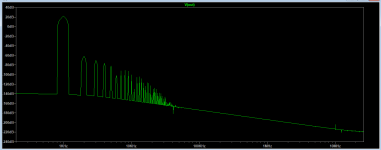 fft2_2.png8.4 KB · Views: 338
fft2_2.png8.4 KB · Views: 338 -
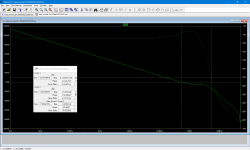 olg_simple_method.png30.9 KB · Views: 600
olg_simple_method.png30.9 KB · Views: 600 -
 thd_follower1.png13.7 KB · Views: 732
thd_follower1.png13.7 KB · Views: 732 -
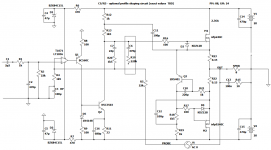 beta_nirvana.20v.mcd.04Mar2022.png27.3 KB · Views: 526
beta_nirvana.20v.mcd.04Mar2022.png27.3 KB · Views: 526 -
beta_nirvana.20v.mcd.04Mar2022.asc10.6 KB · Views: 108
-
 hugh_beta_nirvana_29march2022.png44.1 KB · Views: 517
hugh_beta_nirvana_29march2022.png44.1 KB · Views: 517 -
beta_nirvana.27v.mcd.05Mar2022.asc10.3 KB · Views: 104
Can someone in Germany help?
I’m asking if someone in Germany could help me contact the seller of some speakers I am interested in buying. They are listed on the Kleinanzeigen website. To be able to contact the seller I need to log in to the site, but I cannot do that as you need a German mobile number for the verification process. Would someone be kind enough to help me contact the seller?
Meanwell PSU for powering DC Amp: Earth in Negative? Hum when I fix
- By sanchezxxx
- Power Supplies
- 0 Replies
Just built a Sub using 2x 4Ohm SB acoustics 8" Woofers in dual opposing, bridged config.
To cut costs I'm using an old Alpine MRP M350 Car Amp that can push 350W into 2Ohms, powered with a Meanwell 12V, 30A DC PSU.
Put it all together quickly, tested and it appeared to run perfectly. Sounded great apart from fan noise from the PSU.
Checking over I noticed that in haste I had accidentally wired the earth input from the mains (3 Pin UK with earth) into the negative input on the mean well. When I correctly wire earth to earth I get a rather loud hum from the drivers.
What is the consequence of earth into negative (I guess an unearthed and dangerous PSU). Anyone have any idea how to get rid of the hum?
Cheers
To cut costs I'm using an old Alpine MRP M350 Car Amp that can push 350W into 2Ohms, powered with a Meanwell 12V, 30A DC PSU.
Put it all together quickly, tested and it appeared to run perfectly. Sounded great apart from fan noise from the PSU.
Checking over I noticed that in haste I had accidentally wired the earth input from the mains (3 Pin UK with earth) into the negative input on the mean well. When I correctly wire earth to earth I get a rather loud hum from the drivers.
What is the consequence of earth into negative (I guess an unearthed and dangerous PSU). Anyone have any idea how to get rid of the hum?
Cheers
Sealing leaky connectors
- Construction Tips
- 0 Replies
Hi there,
I'm making a couple of plateamps with a DSP front end on a custom face plate for mounting in a bass reflex enclosure. The faceplate has a few cutouts for gain trim, a toggle for presets and the xlr connectors. How do I make the cutouts airtight?
In the ideal world the dsp board would be covered and sealed completely from the enclosure. But I forgot to add space for a shroud during the design phase, and I've already cut the face plates in aluminium
Before I reach for the hot glue, epoxy or silicone is there a good solution I should be looking into?
I'm making a couple of plateamps with a DSP front end on a custom face plate for mounting in a bass reflex enclosure. The faceplate has a few cutouts for gain trim, a toggle for presets and the xlr connectors. How do I make the cutouts airtight?
In the ideal world the dsp board would be covered and sealed completely from the enclosure. But I forgot to add space for a shroud during the design phase, and I've already cut the face plates in aluminium

Before I reach for the hot glue, epoxy or silicone is there a good solution I should be looking into?
AVM Competition DAC2 upgrade
- By Tesla Audio
- Digital Line Level
- 3 Replies
Hi,
I have old 1998y. AVM Competition DAC2 with dual PCM63 dac chip. I'd like to make upgrade receiver and digital filter chip or for me better make NOS DAC. Receiver chip is Yamaha YM3623B and digital filter DF1700P.
1.OPTION: is to replace Yamaha with DIR9001 and DF1700 with SM5842 or PMD100.
Signalling pins are compatible but not all others.
2. OPTION and for me better to make NOS. In that case I don't need receiver and filter chip,just USB->I2S board like JLSOUND which I have.
PCM63 can directly accept I2S signal from Jlsound.
I/V can be also upgraded. There are 6 opamps 5534D (JRC) which can be replaced.
I asked AVM for schematic but unfortunately they not support DIY.
Any suggestion
I have old 1998y. AVM Competition DAC2 with dual PCM63 dac chip. I'd like to make upgrade receiver and digital filter chip or for me better make NOS DAC. Receiver chip is Yamaha YM3623B and digital filter DF1700P.
1.OPTION: is to replace Yamaha with DIR9001 and DF1700 with SM5842 or PMD100.
Signalling pins are compatible but not all others.
2. OPTION and for me better to make NOS. In that case I don't need receiver and filter chip,just USB->I2S board like JLSOUND which I have.
PCM63 can directly accept I2S signal from Jlsound.
I/V can be also upgraded. There are 6 opamps 5534D (JRC) which can be replaced.
I asked AVM for schematic but unfortunately they not support DIY.
Any suggestion
Attachments
Need help to optimize my LU1014 SRPP amp
- Solid State
- 14 Replies
I have this circuit working well in SIM, I ordered PCB for it to build the real one. How can I reduce the feedback or improve the feedback circuit? ALso, i'm told that top and bottom should hare the same amount of dissipation?
I'm open to ideas and suggestions as is my first homebrew.

I'm open to ideas and suggestions as is my first homebrew.
DEC DE2TU 24VDC 7A 250VAC relay replacement
- By pinifinina
- Solid State
- 15 Replies
Hi everyon,
Does anyone know a replacement relay for DEC DE2TU 24VDC 7A 250VAC? DEC don't make them any more and they have removed the spec sheet from their japanese website. Has anyone done this before? Thank you.
Does anyone know a replacement relay for DEC DE2TU 24VDC 7A 250VAC? DEC don't make them any more and they have removed the spec sheet from their japanese website. Has anyone done this before? Thank you.
Ellips-P: 32W Revelator, 18WE Ellipticor, T34B + WG, this time with pasive crossover
This will be pasive crossover version of previous project with OctoDAC+nanoSHARC:
https://pkaudio.webnode.cz/ellips-a/
First of all, measurements were done in a very large room, speakers were lifted 1,6m above the floor. I also used thick damping material on the floor to mitigate floor reflections.
This provided very good conditions for the measurement, therefore I did just apply 1/12 smoothing and did not do NF merging. After many experiences with merging, I started to look at the smoothed measurements as well. Measurements were done for 0 to -180deg, in 5deg steps, but for better visibility I show just 0-90deg with 10deg steps. Vertical measurements copied from horizontals (Vituix feature).
I had a lot of time to plan and model crossover for this pasive version, and now I am very happy to see it was worthwhile.
Horizontal polars are nearly perfect.
Spinorama graphs, especially power response with no dip at the crossover, and monotonically rising DI look good. Good to see that all features (driver arrangement, crossover slopes, WG, roudovers, etc) all locked in, work in accordance and result in perfect graphs.
From active version I know there is a potential for excellent sound as well.
Crossover parts and cabinets should arrive ~next week...
I visit ASR forum from time to time, to see what loudspeakers are the subjects of worship over there. It seems these Ellips-P could stand among the best measuring loudspeakers, it would be interesting to see how this project performs on Klippel NFS...
https://pkaudio.webnode.cz/ellips-a/
First of all, measurements were done in a very large room, speakers were lifted 1,6m above the floor. I also used thick damping material on the floor to mitigate floor reflections.
This provided very good conditions for the measurement, therefore I did just apply 1/12 smoothing and did not do NF merging. After many experiences with merging, I started to look at the smoothed measurements as well. Measurements were done for 0 to -180deg, in 5deg steps, but for better visibility I show just 0-90deg with 10deg steps. Vertical measurements copied from horizontals (Vituix feature).
I had a lot of time to plan and model crossover for this pasive version, and now I am very happy to see it was worthwhile.
Horizontal polars are nearly perfect.
Spinorama graphs, especially power response with no dip at the crossover, and monotonically rising DI look good. Good to see that all features (driver arrangement, crossover slopes, WG, roudovers, etc) all locked in, work in accordance and result in perfect graphs.
From active version I know there is a potential for excellent sound as well.
Crossover parts and cabinets should arrive ~next week...
I visit ASR forum from time to time, to see what loudspeakers are the subjects of worship over there. It seems these Ellips-P could stand among the best measuring loudspeakers, it would be interesting to see how this project performs on Klippel NFS...
Attachments
-
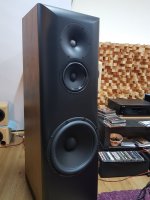 20211125_142102.jpg363.4 KB · Views: 338
20211125_142102.jpg363.4 KB · Views: 338 -
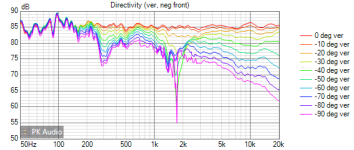 EllipsP v4 Directivity (ver, neg front).png15.9 KB · Views: 264
EllipsP v4 Directivity (ver, neg front).png15.9 KB · Views: 264 -
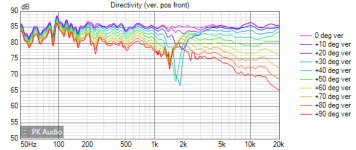 EllipsP v4 Directivity (ver, pos front).png15.8 KB · Views: 296
EllipsP v4 Directivity (ver, pos front).png15.8 KB · Views: 296 -
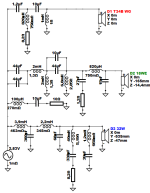 EllipsP v4 XO-schema-1.png13.3 KB · Views: 301
EllipsP v4 XO-schema-1.png13.3 KB · Views: 301 -
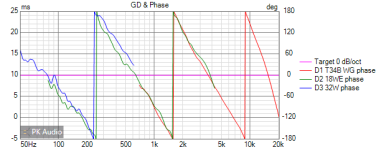 EllipsP v5 GD+Phase.png10 KB · Views: 214
EllipsP v5 GD+Phase.png10 KB · Views: 214 -
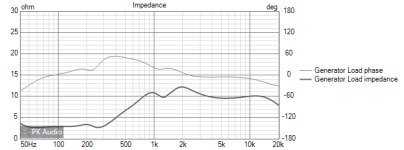 EllipsP v5 Impedance.png6.4 KB · Views: 245
EllipsP v5 Impedance.png6.4 KB · Views: 245 -
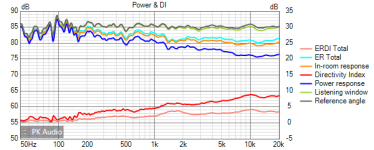 EllipsP v5 Power+DI.png13.1 KB · Views: 208
EllipsP v5 Power+DI.png13.1 KB · Views: 208 -
 EllipsP v5 SPL.png11.8 KB · Views: 216
EllipsP v5 SPL.png11.8 KB · Views: 216 -
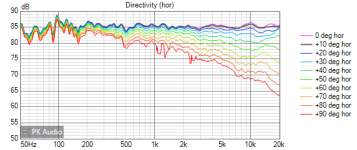 EllipsP v5 Directivity (hor).png14.1 KB · Views: 255
EllipsP v5 Directivity (hor).png14.1 KB · Views: 255
Yamaha A-S3000 ceased from working
- By Kay Pirinha
- Solid State
- 100 Replies
Hi,
all of a sudden my beloved intergrated amplifier stopped working. When I turned it off and on again. I hear relays clicking, the VU meter illumination shortly flashes, then the relays click again, and the Standby LED flashes continuously.
Unfortunately I am not able to upload the service manual here that I found at several WWW sources, because with almost 12 MB it is too large.
According to the instructions given from page 26 on in that manual, I entered the self-diagnostic mode. The Standby LED flashes three times, followed by a short break, then it continuously flashes twice, followed by a short break etc.
This isn't a flashing pattern exactly described in the List of protection information. But if I neglect the first three flashes, the following ones (flash flash break, flash flash break etc.) might correspond with the pattern in the second line and hint to PS (power supply) protection.
The amplifier is of high complexity and the schematics are hard to read, at least for me. I even don't understand how the power output section works, but due to the four floating PSU rails I assume something like a Circlotron. So it might be well beyond my capabilities. Maybe there's another owner of such a beautiful and well sounding unit who has encountered the same or similar issue and fixed it successfully? Any hint will be much appreciated.
Best regards!
all of a sudden my beloved intergrated amplifier stopped working. When I turned it off and on again. I hear relays clicking, the VU meter illumination shortly flashes, then the relays click again, and the Standby LED flashes continuously.
Unfortunately I am not able to upload the service manual here that I found at several WWW sources, because with almost 12 MB it is too large.
According to the instructions given from page 26 on in that manual, I entered the self-diagnostic mode. The Standby LED flashes three times, followed by a short break, then it continuously flashes twice, followed by a short break etc.
This isn't a flashing pattern exactly described in the List of protection information. But if I neglect the first three flashes, the following ones (flash flash break, flash flash break etc.) might correspond with the pattern in the second line and hint to PS (power supply) protection.
The amplifier is of high complexity and the schematics are hard to read, at least for me. I even don't understand how the power output section works, but due to the four floating PSU rails I assume something like a Circlotron. So it might be well beyond my capabilities. Maybe there's another owner of such a beautiful and well sounding unit who has encountered the same or similar issue and fixed it successfully? Any hint will be much appreciated.
Best regards!
Luxman L-410 Amplifier Output Transistors
- Solid State
- 3 Replies
Hello all,
I have been asked to see if I can mend an amplifier, and i'm in a little over my head. I was wondering if anyone had an ideas? :
As the picture shows, what I think is one of the channels output transistors is cooked, everything else seems visually okay. Including the fuse.
I looked up the schematics and parts list , and couldn't really work out which transitor this is, and from general googling it seems like these exact ones aren't made anymore. Does anyone have some advice ?
Thanks!
I have been asked to see if I can mend an amplifier, and i'm in a little over my head. I was wondering if anyone had an ideas? :
As the picture shows, what I think is one of the channels output transistors is cooked, everything else seems visually okay. Including the fuse.
I looked up the schematics and parts list , and couldn't really work out which transitor this is, and from general googling it seems like these exact ones aren't made anymore. Does anyone have some advice ?
Thanks!
Attachments
Stereo. On the floor, for once (Or: The raise of yet another x-talk canceling board)
- By Daihedz
- Room Acoustics & Mods
- 7 Replies
Pets can’t go wrong. They listen to stereo while laying on the floor. Have you ever tried to do the same? If so, do it again. If not, try it out.
Lay down on your back on the floor, so that your face is heading for the ceiling. Your head might be placed at the floor projection your usual sweet spot listening position in the room. And your body then should point away from the stereo basis on it’s central symmetry line, so that your feet point away from the speaker base line. Having placed yourself like this, the loudspeaker base line geometrically will appear away from the apex of your head. As if in a normal upright position, the speakers would hanging above you and pointing down at 30° left and 30° right angles.
Having you eary very close to the floor, there is practically no more floor reflection. The first reflection will be the ceiling reflection, also much weaker and coming in substantially later than usual. This alone makes you listen outside your usual psychoacoustic and room-dimensional envelope.
Then add a an upside board onto the symmetry line of the stereo basis, nearly touching the apex of your head. This board will cancel most of the inter-ear x-talk, which makes for another psychoacoustic change.
Then close your eyes, thus shutting down any visual orientation.
Doing so, you have
Still, you can further enhance the experience, because there is a drawback about this x-talk canceling board. It adds it’s own, early reflection. Therefore, I fitted a kind of deluxe-board with some PET woven acoustical absorber panels. The result then is near-breathtaking.
Therefore, here some comments and pictures about this improved xtalk-canceling board. First have a look at it's simple construction. It roughly measures 60cm x 80cm and is made of birch plywood:



The narrow side is where the head will be placed during the hearing session, the open side points to the speakers base line.
Now, how effective is it? Measurements will tell. Using a calibrated dummy head ...

... which undoubtfully was a wee bit larger than live ...

... some measurements were performed.


The results were quite conclusive:

Red and Green are the graphs for same-side stimulus and measurements.
Red is the difference between the [ right channel mic'ed on the right side ] and the [ left channel mic'ed on the left side ]. Measured "free field", without the x-talk canceller board.
Green is the same, but measured with the x-talk canceller board between the speakers and the dummy head.
Both curves hover around the zero lines and show no big differences. In the conclusion, for the direct same-side-pathways there is no big difference wheter the x-talk canceller board is placed, or wheter it is ommited.
Blue and Black are the curves of the R->L crossing acoustical pathways measurements difference.
Blue is as above the difference without the x-talk canceller board (baffle). This curve shows some "natural" spl cancellation of the crossing pathway due to the dummy head shading.
Black is the same, but with the x-talk canceller board obturating the crossing soundpath installed. It's effect is quite impressive: The damping of the board for the crossing soundpath is in the range of 10dB below 1kHz and raising well above 20dB at 10kHz.
So, the effectiveness of this x-path cancelling deluxe board is quite evident. Once from the measurement's results, and also in terms of an effect for the aformentionned soundstage.
Made you curious? Happy laying down and happy boarding, then !!! You won't probably regret it.
Lay down on your back on the floor, so that your face is heading for the ceiling. Your head might be placed at the floor projection your usual sweet spot listening position in the room. And your body then should point away from the stereo basis on it’s central symmetry line, so that your feet point away from the speaker base line. Having placed yourself like this, the loudspeaker base line geometrically will appear away from the apex of your head. As if in a normal upright position, the speakers would hanging above you and pointing down at 30° left and 30° right angles.
Having you eary very close to the floor, there is practically no more floor reflection. The first reflection will be the ceiling reflection, also much weaker and coming in substantially later than usual. This alone makes you listen outside your usual psychoacoustic and room-dimensional envelope.
Then add a an upside board onto the symmetry line of the stereo basis, nearly touching the apex of your head. This board will cancel most of the inter-ear x-talk, which makes for another psychoacoustic change.
Then close your eyes, thus shutting down any visual orientation.
Doing so, you have
- shut down acoustical info about the height of your head over ground level (no floor reflection)
- psychoacoustically changed the usual room height, or left the room altogether (ceiling reflection)
- sharpened left-right discrimination (no x-talk)
- sharpened your auditive perception in general (by closing the eyes)
- the sound seems to be coming from a very unusual direction (body related from above you)
- a maybe easier relaxation in the lying position
Still, you can further enhance the experience, because there is a drawback about this x-talk canceling board. It adds it’s own, early reflection. Therefore, I fitted a kind of deluxe-board with some PET woven acoustical absorber panels. The result then is near-breathtaking.
Therefore, here some comments and pictures about this improved xtalk-canceling board. First have a look at it's simple construction. It roughly measures 60cm x 80cm and is made of birch plywood:
The narrow side is where the head will be placed during the hearing session, the open side points to the speakers base line.
Now, how effective is it? Measurements will tell. Using a calibrated dummy head ...
... which undoubtfully was a wee bit larger than live ...
... some measurements were performed.
The results were quite conclusive:
Red and Green are the graphs for same-side stimulus and measurements.
Red is the difference between the [ right channel mic'ed on the right side ] and the [ left channel mic'ed on the left side ]. Measured "free field", without the x-talk canceller board.
Green is the same, but measured with the x-talk canceller board between the speakers and the dummy head.
Both curves hover around the zero lines and show no big differences. In the conclusion, for the direct same-side-pathways there is no big difference wheter the x-talk canceller board is placed, or wheter it is ommited.
Blue and Black are the curves of the R->L crossing acoustical pathways measurements difference.
Blue is as above the difference without the x-talk canceller board (baffle). This curve shows some "natural" spl cancellation of the crossing pathway due to the dummy head shading.
Black is the same, but with the x-talk canceller board obturating the crossing soundpath installed. It's effect is quite impressive: The damping of the board for the crossing soundpath is in the range of 10dB below 1kHz and raising well above 20dB at 10kHz.
So, the effectiveness of this x-path cancelling deluxe board is quite evident. Once from the measurement's results, and also in terms of an effect for the aformentionned soundstage.
Made you curious? Happy laying down and happy boarding, then !!! You won't probably regret it.
Hypex FA251 plate amp
- By Geluidloopt
- Swap Meet
- 2 Replies
Selling 1x Hypex FA251 plate amp.
NIB, tested once
250W/4ohm
130W/8ohm
SOLD
NIB, tested once
250W/4ohm
130W/8ohm
SOLD
Attachments
For Sale Muffsy relay 4 input selector
- Swap Meet
- 1 Replies
For sale:
Muffsy relay 4 input selector, see link : https://www.muffsy.com/muffsy-relay-input-selector-4

Asking EUR 40 plus shipping from The Netherlands.
Muffsy relay 4 input selector, see link : https://www.muffsy.com/muffsy-relay-input-selector-4
Asking EUR 40 plus shipping from The Netherlands.
SRPP using beefy depletion mode IXTH16N10D2 mosfet instead of LU1014D
- Pass Labs
- 3 Replies
I will take one last stab at trying to use the IXYS16N10D2 depletion mode mosfets as a drop-in for the LU1014D devices which were originally provisioned in this SRPP based design. I started to sim with them and find that they are working in simulation but with high THD. My objective is try to re-use the PCB enough for testing them revise them if I ever get it working better to produce 10-20w into 8 ohm with lower THD.
Any design advice, encouragements and suggestions are welcome!
My test jig:
![IMG_0012[1].JPG IMG_0012[1].JPG](https://www.diyaudio.com/community/attachments/img_0012-1-jpg.1206199/)

Any design advice, encouragements and suggestions are welcome!
My test jig:
HP 4263A RLC bridge schematic
- By panos29
- Equipment & Tools
- 8 Replies
I have a wonderful HP 4263A RLC bridge that I truly love but the function of external DC biasing is not working. Thus I would love to have the schematic in order to find out if I may be able to repair the fault.
If anyone have any documentation with the schematic, I would really love to have it as HP seems to have nothing on this meter as it seems to be built by Yokogawa Japan.
thank you!
If anyone have any documentation with the schematic, I would really love to have it as HP seems to have nothing on this meter as it seems to be built by Yokogawa Japan.
thank you!
Attachments
Full Range Array
- By WFCkeyman
- Full Range
- 20 Replies
Who has built such an array? Any comments? Is that very hard to drive?
Attachments
More phono gain out of the Hafler IRIS Preamp?
- By baldrick
- Analog Line Level
- 3 Replies
I'm running a Soundsmith cartridge into a Hafler IRIS preamp.
Because it's a moving iron design it has a lower output than most MM cartridges.
It sounds great, and the IRIS's internal phono stage is pretty good, but I'd love to get a few more db of gain out of the phono stage.
Looking at the schematic, the only difference I can tell between MM mode and MC mode is the insertion of a 100 ohm load resistor, the removal of the 220 pF load capacitor. As well as the bypassing of a 316 ohm resistor in MC mode.
I've included the schematic of the phono stage portion of the preamp, and I've edited it into what I believe is the circuit diagram because the original schematic on the inter webs is pretty low contrast.
Is it correct that this 316 ohm resistor regulates the gain of the phono stage? The preamp bypasses it when you press the switch on the back panel from MM mode to MC mode (along with the aforementioned load resistor and capacitor), so would modifying this resistor to a lower value increase the gain of the cuicuit?
Because it's a moving iron design it has a lower output than most MM cartridges.
It sounds great, and the IRIS's internal phono stage is pretty good, but I'd love to get a few more db of gain out of the phono stage.
Looking at the schematic, the only difference I can tell between MM mode and MC mode is the insertion of a 100 ohm load resistor, the removal of the 220 pF load capacitor. As well as the bypassing of a 316 ohm resistor in MC mode.
I've included the schematic of the phono stage portion of the preamp, and I've edited it into what I believe is the circuit diagram because the original schematic on the inter webs is pretty low contrast.
Is it correct that this 316 ohm resistor regulates the gain of the phono stage? The preamp bypasses it when you press the switch on the back panel from MM mode to MC mode (along with the aforementioned load resistor and capacitor), so would modifying this resistor to a lower value increase the gain of the cuicuit?
Attachments
Uneven Filament Wear of DC heated DHT’s, Truth or Myth
- By gupsta
- Tubes / Valves
- 95 Replies
Using my Utracer, I measured a type 45 that has seen some use in a DC heated amp. I don’t know how many hours of use it has had and I don’t have results from when the tube was new to compare. The book valve states 34ma at 250vdc, -50v bias, but she only gives around 25ma. That said the curves still look okay and with reduced heater voltage they’re still quite steep so I guess there is still some life left in her.
Anyway, this got me wondering about uneven heater wear, so I retested it switching the heater terminals (still measuring w.r.t the 0v lead), and the results were exactly the same which suggests to me that uneven filament wear is a myth. The low heater/ high bias of the type 45, perhaps wouldn’t make it a good example for demonstrating uneven filament wear. Perhaps the critical point is to maintain the “space charge” by not exceeding the current limit, and if that is accomplished then no uneven filament wear occurs.
A lower filament temperature would presumably reduce the rate of barium evaporation at the expense of available current to maintain the space charge. Testing the 45 at reduced heater voltages of 2.2v and 1.9v (30v-bias), the curve/gradient for 2.2v was similar to 2.5v but plotted a small step beneath. At 1.9v it followed the same principle until about 30ma, above which the gradient levelled off, which makes me think at that point the current is starting to be drawn directly from the filament rather than from the space charge. Perhaps an optimum filament voltage can be established from this approach for a given tube.
I’ve not got much past experience to work on and was wondering if others have measured differences on a tester or perhaps found different bias points when switching the filament terminals.
I would think that if uneven filament wear was truth then it would be well proven/documented, but I haven’t spotted anything.

Anyway, this got me wondering about uneven heater wear, so I retested it switching the heater terminals (still measuring w.r.t the 0v lead), and the results were exactly the same which suggests to me that uneven filament wear is a myth. The low heater/ high bias of the type 45, perhaps wouldn’t make it a good example for demonstrating uneven filament wear. Perhaps the critical point is to maintain the “space charge” by not exceeding the current limit, and if that is accomplished then no uneven filament wear occurs.
A lower filament temperature would presumably reduce the rate of barium evaporation at the expense of available current to maintain the space charge. Testing the 45 at reduced heater voltages of 2.2v and 1.9v (30v-bias), the curve/gradient for 2.2v was similar to 2.5v but plotted a small step beneath. At 1.9v it followed the same principle until about 30ma, above which the gradient levelled off, which makes me think at that point the current is starting to be drawn directly from the filament rather than from the space charge. Perhaps an optimum filament voltage can be established from this approach for a given tube.
I’ve not got much past experience to work on and was wondering if others have measured differences on a tester or perhaps found different bias points when switching the filament terminals.
I would think that if uneven filament wear was truth then it would be well proven/documented, but I haven’t spotted anything.
Estimating basket volume
- By Studley
- Subwoofers
- 4 Replies
I plan on making a couple of sealed subs using a pair of the legendary Aurasound NS15 woofers. I’m decidling on the box volume but I need to make an allowance for the huge magnets and frames of these woofers. Is there an approved method for estimating the volume displacement within the box?
Boston Acoustics GT-42 R and L Channel Outputs Uneven
- By Oppenheimer
- Car Audio
- 27 Replies
I have a GT-42 that both FR and RR channels are about 1/2 the output of the FL and RL channels. This seems to be a problem with these amps but I have not found someone come back and say how or if they fixed it. https://www.diyaudio.com/community/threads/boston-gt-40.370270/
The amp had a burnt/open 4R70 resistor R112 on channel FL. The board was burned under it and one pad has lifted although it is still connect to the trace going under the 100 nF polyester film capacitor. Output fet drain-->100nF cap-->R112-->secondary ground/non-bridging speaker terminal. I now have 7- 1/4w 33R resistors paralleled off the board for 4R7, for testing.
The amp had no output on any channels and about 500 mVdc across the speaker terminals. I found the negative regulated supply was not being produced for the op-amps and found a loose connection on the BC53, Q85, fixed that.
Now I have no DC across speaker terminals and I have audio on all 4 channels. Problem is both right channels front and rear have 1/2 the output (4 Vpp) of both left channels front and rear (8 Vpp) with 100 Hz sine wave. I have the same magnitude of the signal on the input side of the 1 uF caps C38, C42, C46, C50, but different outputs, relative to front and rear, on the 5532s within the output side.
Both gains turned full ccw, least sensitive. I have tried multiple switch positions, switching inputs L or R and L & R, different sources.
Of course a schematic would be great. I have the one for the GT-28 in the previous thread I linked to and also downloaded some STEG schematics, but they are to dissimilar.
I can take more/different pictures if necessary. The discoloration in the picture of the regulated voltage section is not there that is a reflection I guess.
Any help would be appreciated.
The amp had a burnt/open 4R70 resistor R112 on channel FL. The board was burned under it and one pad has lifted although it is still connect to the trace going under the 100 nF polyester film capacitor. Output fet drain-->100nF cap-->R112-->secondary ground/non-bridging speaker terminal. I now have 7- 1/4w 33R resistors paralleled off the board for 4R7, for testing.
The amp had no output on any channels and about 500 mVdc across the speaker terminals. I found the negative regulated supply was not being produced for the op-amps and found a loose connection on the BC53, Q85, fixed that.
Now I have no DC across speaker terminals and I have audio on all 4 channels. Problem is both right channels front and rear have 1/2 the output (4 Vpp) of both left channels front and rear (8 Vpp) with 100 Hz sine wave. I have the same magnitude of the signal on the input side of the 1 uF caps C38, C42, C46, C50, but different outputs, relative to front and rear, on the 5532s within the output side.
Both gains turned full ccw, least sensitive. I have tried multiple switch positions, switching inputs L or R and L & R, different sources.
Of course a schematic would be great. I have the one for the GT-28 in the previous thread I linked to and also downloaded some STEG schematics, but they are to dissimilar.
I can take more/different pictures if necessary. The discoloration in the picture of the regulated voltage section is not there that is a reflection I guess.
Any help would be appreciated.
Attachments
-
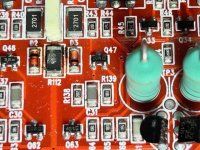 Open Burnt Resistor.jpg120.5 KB · Views: 158
Open Burnt Resistor.jpg120.5 KB · Views: 158 -
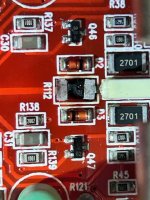 Burnt Board Pad Lifted.jpg74.5 KB · Views: 150
Burnt Board Pad Lifted.jpg74.5 KB · Views: 150 -
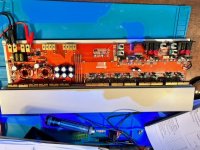 GT-42.jpg72.4 KB · Views: 212
GT-42.jpg72.4 KB · Views: 212 -
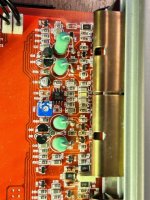 1 Channel.jpg78.6 KB · Views: 151
1 Channel.jpg78.6 KB · Views: 151 -
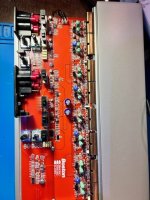 Front End and Output.jpg72.9 KB · Views: 159
Front End and Output.jpg72.9 KB · Views: 159 -
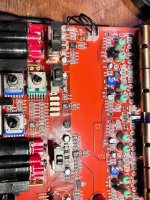 Front End and 2 Output Channels.jpg737.2 KB · Views: 182
Front End and 2 Output Channels.jpg737.2 KB · Views: 182 -
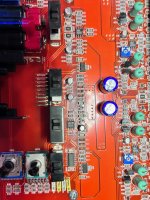 Regulated Voltage.jpg657.7 KB · Views: 153
Regulated Voltage.jpg657.7 KB · Views: 153 -
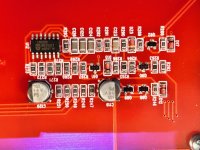 LM339.jpg414.7 KB · Views: 149
LM339.jpg414.7 KB · Views: 149
WTB Capmx PSU boards - Rudi Ratlos
Does anyone have any CapMX PSU boards from Rudi Ratlos?
I’m wanting to use them for a mofo amp. I would also be interested in other CapMX boards or even a single rail SLB.
Thanks.
I’m wanting to use them for a mofo amp. I would also be interested in other CapMX boards or even a single rail SLB.
Thanks.
Multiple dead amplfiers while living by a radio broadcast tower
- Solid State
- 8 Replies
Hi Everyone,
I have a curious problem that I'm hoping to get some input on. About 5 years ago I moved to a house that is right across the street from a radio broadcast tower. The radio tower broadcasts FM, cellular, and I'm told, many other types of RF. I have experienced a number of add RF interference issues living here such as car remotes that don't work, garage door openers with reduced range, and I often pickup faint FM radio signals on audio equipment when on the upper level of my house. Fortunately my basement audio listening room seems to be largely immune to any unwanted radio signals (even my MC phono stage!).
For the last 20 years or so I have kept an basic integrated amplfier of some sort in my home office with a pair of mini-monitors on my desk for both music and media consumption through a PC; I typically leave the amp on at all times since I'm often in and out of my office multiple times throughout the day. In the time I've been in this house I've had at least 5 integrated amps die overnight while powered on in my office. I've changed the speakers several times, the PC, and the connection type (analog, toslink, USB), as well as power conditioners, so there's really nothing common about these failures other than me living in this location.
Does is seem plausable that some stray RF is sending these amps in to oscillation and a premature death? If so, is there anything I might look for in an amp to avoid these issues (class D have been more reliable, and never seem to play audible FM)? Would shielding on cables or some type of filter or zobel network on the inputs / outputs offer protection?
The good news in all of this is that I have a stack of dead amps that I can use for amplifier repair practice.
Any thoughts on this will be appreciated!
I have a curious problem that I'm hoping to get some input on. About 5 years ago I moved to a house that is right across the street from a radio broadcast tower. The radio tower broadcasts FM, cellular, and I'm told, many other types of RF. I have experienced a number of add RF interference issues living here such as car remotes that don't work, garage door openers with reduced range, and I often pickup faint FM radio signals on audio equipment when on the upper level of my house. Fortunately my basement audio listening room seems to be largely immune to any unwanted radio signals (even my MC phono stage!).
For the last 20 years or so I have kept an basic integrated amplfier of some sort in my home office with a pair of mini-monitors on my desk for both music and media consumption through a PC; I typically leave the amp on at all times since I'm often in and out of my office multiple times throughout the day. In the time I've been in this house I've had at least 5 integrated amps die overnight while powered on in my office. I've changed the speakers several times, the PC, and the connection type (analog, toslink, USB), as well as power conditioners, so there's really nothing common about these failures other than me living in this location.
Does is seem plausable that some stray RF is sending these amps in to oscillation and a premature death? If so, is there anything I might look for in an amp to avoid these issues (class D have been more reliable, and never seem to play audible FM)? Would shielding on cables or some type of filter or zobel network on the inputs / outputs offer protection?
The good news in all of this is that I have a stack of dead amps that I can use for amplifier repair practice.
Any thoughts on this will be appreciated!
CSS APR Passive Radiator Help!
- By HighFutility
- Subwoofers
- 1 Replies
Hey everyone, I am not familiar with the specs listed for the CSS passive radiator line. Is XSUS the same as x-max? Is Vap Vas? Trying to model the radiators with a driver, but am unsure of the correct inputs or if the values mean something else.

Attachments
Sound magus x3200
- By petercourt
- Car Audio
- 43 Replies
Hi. Just out of curiosity does anyone have any photos or even better a scematic of the sound magus x3200?
Reason I ask is I have a bunch of sound magus 1500 boards here I'd like to try and link like they did in the x3200 model.
This is just to practise and learn. Not going to bother to build a case and use it.
I see there are a few photos on Facebook but I can't seem to open them...
Thanks
Reason I ask is I have a bunch of sound magus 1500 boards here I'd like to try and link like they did in the x3200 model.
This is just to practise and learn. Not going to bother to build a case and use it.
I see there are a few photos on Facebook but I can't seem to open them...
Thanks
Starving Student Tubes
Hi, all,
I have several pairs of Starving Student tubes, 18FX6As, for sale. I've got too many headphone amps at the moment, so will be getting rid of that one. (Posting to come.) Here's what I have:
Price is $10 per pair for the GE, Sylvania, and RCAs, plus actual shipping costs, to be calculated at time of sale. I"m in the US, so if you are, too, then we're likely looking at $5-8. For the Raytheons, it's just $6, plus shipping.
PM me if interested.
Riki
I have several pairs of Starving Student tubes, 18FX6As, for sale. I've got too many headphone amps at the moment, so will be getting rid of that one. (Posting to come.) Here's what I have:
General Electric (one pair)Sylvania (one pair)RCA (one pair)- Raytheon (two pairs)
PM me if interested.
Riki
Passive LC ladder filter synthesis - I need to chat with an expert!
- By CharlieLaub
- Analog Line Level
- 25 Replies
I need the advice of an expert filter designer who is knowledgeable in passive ladder synthesis of filters with stopband zeros. I have some non-standard filters and would like to explore how they might be synthesized passively, pros and cons of trying that, etc. Examples of filters of this type are elliptic and Chebyshev filters. This would be for a passive, active, or actively-buffered passive line level non-commercial audio application. I am generally familiar audio filter design, although mostly for IIR digital loudspeaker crossover applications.
If you know your way around this topic (not just how to push buttons on a filter design program) I would really appreciate your time and advice. Please drop me a PM and I will explain more.
If you know your way around this topic (not just how to push buttons on a filter design program) I would really appreciate your time and advice. Please drop me a PM and I will explain more.
Older unused electrolytics and reforming
- Parts
- 5 Replies
I’m sure this has been asked a bajillion times, but here’s +1.
I have a populated diytube ST-35 pcb that a friend gave me back in 2010. It was populated I’m assuming 3-5 years before that. I assume it’d be best to swap out all the Nichicon VZ ps caps and the few others as well as opposed to trying to reform them in circuit?
I have a populated diytube ST-35 pcb that a friend gave me back in 2010. It was populated I’m assuming 3-5 years before that. I assume it’d be best to swap out all the Nichicon VZ ps caps and the few others as well as opposed to trying to reform them in circuit?
Attachments
Switching Out between two Ins: trying to prevent amps from buzzing when not connected to Output
- By mo7ies
- Analog Line Level
- 12 Replies
Stereo line-level DIY audio switch, trying to block the buzz when not connected.
Recommended values R1-R4? I imagine not too low as to noticeably load the Output, yet low enough to cut the interference (the amps are buzzing when inputs are not connected.)
Is this even the best way to prevent the buzz/interference?
Thanks.

Recommended values R1-R4? I imagine not too low as to noticeably load the Output, yet low enough to cut the interference (the amps are buzzing when inputs are not connected.)
Is this even the best way to prevent the buzz/interference?
Thanks.
Diode coating in Realistic SA-102
- By jcandy
- Solid State
- 7 Replies
Let me preface by saying that I know very little about amplifiers. The diodes (VD1121) between the transistors in the Realistic SA-102 (circa 1980) appear to be coated with silicone. See images here, and also attached. Is this an attempt at thermally coupling them to the transistors?
Attachments
WTB Shiga MK2, complete or as a kit
- By Staxman2022
- Swap Meet
- 1 Replies
Hi
If anyone has Vicol Shiga Mk2 that they are willing to sell, or a kit they bought but never assembled, or even a partial kit, I am willing to buy it. send me an offer and let's make a deal. Prefereably in the EU but even if you're somewhere else, send me an offer.
If anyone has Vicol Shiga Mk2 that they are willing to sell, or a kit they bought but never assembled, or even a partial kit, I am willing to buy it. send me an offer and let's make a deal. Prefereably in the EU but even if you're somewhere else, send me an offer.
Bogen RM-300
- By knockbill
- PA Systems
- 5 Replies
I got a Bogen RM-300 at a radio show last week,,, seems to work good on all inputs except AM,,, I found an operation manual but no schematic anywhere, any one have any info, or schem to share for this one??
Thanks..
Thanks..
Pioneer SM-R150
- By OldHector
- Tubes / Valves
- 24 Replies
My auction-bidding-finger has been at it again, and now I am the proud owner of a Pioneer SM-R150.
The supply voltage is 100V or 117V. The output tubes are 6AR5 in push pull, and max power is 15W from both chanels.
I have seen a 100W supply for 110V for sale, and was wondering if that would be enough for a supply, so I can run it with its existing transformer. Unfortunately I can't find too much data about this amplifier, so I do not have a supply power rating for it. Would it be pushing it a bit to much to use a simple 100W adaptor for the supply?
Also, apart from the electrolytics, the other components seem to be a departure from the normal wax covered capacitors and carbon resistors found in similar vintage amplifiers. The capacitors are marked 'Oil Imp.', presumably oil impregnated. Is there anything that should be replaced as a matter of course, before I try to poer it up?
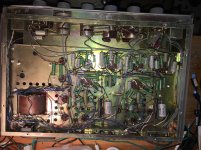
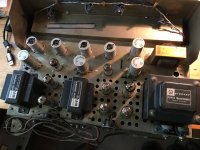
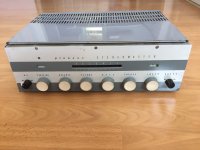
The supply voltage is 100V or 117V. The output tubes are 6AR5 in push pull, and max power is 15W from both chanels.
I have seen a 100W supply for 110V for sale, and was wondering if that would be enough for a supply, so I can run it with its existing transformer. Unfortunately I can't find too much data about this amplifier, so I do not have a supply power rating for it. Would it be pushing it a bit to much to use a simple 100W adaptor for the supply?
Also, apart from the electrolytics, the other components seem to be a departure from the normal wax covered capacitors and carbon resistors found in similar vintage amplifiers. The capacitors are marked 'Oil Imp.', presumably oil impregnated. Is there anything that should be replaced as a matter of course, before I try to poer it up?



Attachments
Help me fix Hitachi Amplifier
- By xXBrunoXx
- Solid State
- 22 Replies
Hello, I'm trying to fix my friend's amplifier. It's an old Hitachi hta-4000 .
He said it won't play anymore. I have turned it on, no output, Vu meter is not working either but on this amp it shows the output power in watts, so no output , it does nto show anything. I measured DC on output it is 0.4v on both channels, that's kind of high.
I tear it apart, output transistors are alive. I have the service manual. it's a weird amp at least for my eyes.
It uses some " metal fuse resistors " I never heard about until now. I bet some of them are burnt, Can I replace them with regular resistors , same value? but then it won't have " protection" anymore. Please take a look at the manual / schematic. Maybe you can guide me a bit on what could be wrong.
I suspect these fuse resistors, since the output transistors are alive.
He used it with a fan on the heatsink, so no over heating issue, but I bet he listened very loud for a long time and something went wrong .
Thank you, Bruno.
He said it won't play anymore. I have turned it on, no output, Vu meter is not working either but on this amp it shows the output power in watts, so no output , it does nto show anything. I measured DC on output it is 0.4v on both channels, that's kind of high.
I tear it apart, output transistors are alive. I have the service manual. it's a weird amp at least for my eyes.
It uses some " metal fuse resistors " I never heard about until now. I bet some of them are burnt, Can I replace them with regular resistors , same value? but then it won't have " protection" anymore. Please take a look at the manual / schematic. Maybe you can guide me a bit on what could be wrong.
I suspect these fuse resistors, since the output transistors are alive.
He used it with a fan on the heatsink, so no over heating issue, but I bet he listened very loud for a long time and something went wrong .
Thank you, Bruno.
Attachments
Surprising op amp measurements
- By diyralf
- Analog Line Level
- 54 Replies
Is there an explanation for the poor performance of the LM4562? The LM4562 should at least be better than the NE5532 at THD. I'm disappointed.
Attachments
For Sale Yamaha D2040 (Europe)
SOLD
I have for sale my old Yamaha D2040 crossover. The unit is fully functional. The top cover has some scratches on it from rack mounting. The only modification is a silent running fan replacement. But airflow is still more than sufficient to let the unit run cool.
Manual is available in digital format on the yamaha website.
I'd like to have 400,- Eur and that includes shipping to most of Europe ( I have to check first).
I have for sale my old Yamaha D2040 crossover. The unit is fully functional. The top cover has some scratches on it from rack mounting. The only modification is a silent running fan replacement. But airflow is still more than sufficient to let the unit run cool.
Manual is available in digital format on the yamaha website.
I'd like to have 400,- Eur and that includes shipping to most of Europe ( I have to check first).
Attachments
Aleph 30 PS advice
Dear diyers
Yes, I'm building an Aleph 30 for me, despite it's an old Mr. Pass design. I love it.
I've already soldered the main parts. Lucky me, I could find two big alluminium heatsinks from two decommissioned 1 kW radio transmitters, so two sides of the enclosure are done. The other sides will be alluminium plates.
My question:
I'm attaching the power supply scheme to see if everything is in order. I followed almost the original Mr. Pass design, but the transformer and the thermistors are european (german transformer and Epcos thermistors) so I would like to know if anyone envisages potential problems, before making the complete PS (by now I only soldered the capacitors, the CRC part).
Additional comment:
Despite I was able to match the input mosfets (IRF9610) to 3.707 V (exact match for both in rigth channel) and 3.699 + 3.700 (for the left channel) using 12Vdc and 1.5kOhm resistor, I put some receptacles in R8 position (just in case).
If anyone is interested, Digikey part 9900-0-15-80-22-27-04-0 will fit for purpose for any 1/4 watt resistor.
Acknowledgement:
I was able to do the diy work I did only because I found information and learned a lot on this site, so thanks to all.
It will take some time to finish the alluminium (enclosure) works. I hope will be able to share some pictures then.
Thanks
Yes, I'm building an Aleph 30 for me, despite it's an old Mr. Pass design. I love it.
I've already soldered the main parts. Lucky me, I could find two big alluminium heatsinks from two decommissioned 1 kW radio transmitters, so two sides of the enclosure are done. The other sides will be alluminium plates.
My question:
I'm attaching the power supply scheme to see if everything is in order. I followed almost the original Mr. Pass design, but the transformer and the thermistors are european (german transformer and Epcos thermistors) so I would like to know if anyone envisages potential problems, before making the complete PS (by now I only soldered the capacitors, the CRC part).
Additional comment:
Despite I was able to match the input mosfets (IRF9610) to 3.707 V (exact match for both in rigth channel) and 3.699 + 3.700 (for the left channel) using 12Vdc and 1.5kOhm resistor, I put some receptacles in R8 position (just in case).
If anyone is interested, Digikey part 9900-0-15-80-22-27-04-0 will fit for purpose for any 1/4 watt resistor.
Acknowledgement:
I was able to do the diy work I did only because I found information and learned a lot on this site, so thanks to all.
It will take some time to finish the alluminium (enclosure) works. I hope will be able to share some pictures then.
Thanks
Acoustic Elegance 18” - Help Needed
- Subwoofers
- 14 Replies
Hey guys- need some help. I’ve ordered acoustic elegance drivers the TD18 and I can’t reach them- I’m just trying to get the baffle machined in the mean time- I tried messaging folks that I’ve seen have these but being new it won’t let me … does anyone know the dimensions of the outer frame diameter? Any help would be appreciated thanks
(not sure where this fits) DAC volume control vs Potentiomater/external volume control
- By mrjayviper
- Digital Line Level
- 3 Replies
The 2 DACs I have already has digital volume control which I believe are provided by the AKM/ESS chip.
Do I still need volume attenuation/pot at the preamp/ headphone amp input?
Thanks
Do I still need volume attenuation/pot at the preamp/ headphone amp input?
Thanks
What do I need to add to 2 *350 subs to make a full PA
- By Rubadub
- PA Systems
- 1 Replies
Hi Im building a small PA for reggae and house gigs.
I have 2 good 350W subs, I was using 2 150W KAM speakers as tops up until now.
We have had a few successful gigs and want to take the PA to the next stage by adding a crossover &
proper tops. Up until now i have been daisy chaining the the system from one 2 channel tAmp - 2x 500 W at 4 Ohm, 2x 350 W at 8 Ohm
1) Are proper tops just new speakers sitting on top of subs or are they a specific type of speaker (or both)
2) What size tops should I have to balance with 2* 350W subs
3) Can you recommend a good crossover ?, is it worth using a crossover, should i just stay with daisychain.
Thanks in advance, apologies for the novice questions but you have to start somewhere I suppose 🙂
I have 2 good 350W subs, I was using 2 150W KAM speakers as tops up until now.
We have had a few successful gigs and want to take the PA to the next stage by adding a crossover &
proper tops. Up until now i have been daisy chaining the the system from one 2 channel tAmp - 2x 500 W at 4 Ohm, 2x 350 W at 8 Ohm
1) Are proper tops just new speakers sitting on top of subs or are they a specific type of speaker (or both)
2) What size tops should I have to balance with 2* 350W subs
3) Can you recommend a good crossover ?, is it worth using a crossover, should i just stay with daisychain.
Thanks in advance, apologies for the novice questions but you have to start somewhere I suppose 🙂
Merlin phono preamp + extra gain stage
- By emartine
- Tubes / Valves
- 43 Replies
Hello there!
Im thinking of building Merlin's phono preamp, and I have thought of adding and extra gain stage at the end so it can drive my Kegger KT88 amplifier.
15db of gain would be more than enough.
I have a bunch of 6922 to use. So I'll choose that tube for the extra stage.
First question, what's best, potentiometer at begginning of extra gain stage or after (at the very end of the preamp)?
I know the position of the volume control would alter the output impedance on the later, but.. do not think would be a problem with the 1M input impedance of the Kegger amplifier.
I have also though of adding a BALANCE control (the lineal balance/log volume control. suggested by both Merlin / Jones).
I believe those have a attenuation of near 9db in the center position, right?
Thanks for your help!🙂
Im thinking of building Merlin's phono preamp, and I have thought of adding and extra gain stage at the end so it can drive my Kegger KT88 amplifier.
15db of gain would be more than enough.
I have a bunch of 6922 to use. So I'll choose that tube for the extra stage.
First question, what's best, potentiometer at begginning of extra gain stage or after (at the very end of the preamp)?
I know the position of the volume control would alter the output impedance on the later, but.. do not think would be a problem with the 1M input impedance of the Kegger amplifier.
I have also though of adding a BALANCE control (the lineal balance/log volume control. suggested by both Merlin / Jones).
I believe those have a attenuation of near 9db in the center position, right?
Thanks for your help!🙂
CR Developments Romulus
- By CharlesArm
- Tubes / Valves
- 3 Replies
Hi!
It's time to replace the Capacitors and tubes in my amplifier.
I have some questions :
Can I replace these Nichicon capacitors with Mundorf Oil?
What are these gray capacitors? And of what value?
Which tubes will be the best?


It's time to replace the Capacitors and tubes in my amplifier.
I have some questions :
Can I replace these Nichicon capacitors with Mundorf Oil?
What are these gray capacitors? And of what value?
Which tubes will be the best?
ATT Perry Babin
- By petercourt
- Car Audio
- 20 Replies
Hey perry. Wanting to purchase you're repair guide. I had a bit of a google but could not find any purchase info. Tried to message u here but was unable to find how to message u.
Could u please message me perry to discus more. (Few questions on how to make it work on win10.
Thanks
Could u please message me perry to discus more. (Few questions on how to make it work on win10.
Thanks
Phase Research Loudspeaker - Polydax/Audax inside; which currently Brand Name ?
- Multi-Way
- 29 Replies
The US brand name "Phase Research" exist in the late 70th years (arround 1976-1979 - I think). In this aera I buy this two way loudspeaker and I have it still in use because its very good sound quality in the television room.
Inside are transducers from the brand Polydax/Audax - see the attached photos.
A very special future was a accessories suitcase for the bass transducer recone kit and other stuff
The carrier plate of the dome tweeter must cut with a small saw so that it could be mounted as close as possible to the upper corner (looks like last cuttet picture).
The bass was front mounted with a spacer ring and the tweeter from behind the baffle.
Therefore the delay error was compensated and thus the brand name - so I think.
Who knows more about the currently brand name
(if I recall right, "Phase Research" was overtaken from an other manufacturer) ?
The tweeter is still available (model No now TW034 instead "HD 13 D 34 H"), also recone kits therefore.
But the bass transducer I don't find in the currently Audax range.
On the web I don't find informations about this brand name.
Inside are transducers from the brand Polydax/Audax - see the attached photos.
A very special future was a accessories suitcase for the bass transducer recone kit and other stuff
The carrier plate of the dome tweeter must cut with a small saw so that it could be mounted as close as possible to the upper corner (looks like last cuttet picture).
The bass was front mounted with a spacer ring and the tweeter from behind the baffle.
Therefore the delay error was compensated and thus the brand name - so I think.
Who knows more about the currently brand name
(if I recall right, "Phase Research" was overtaken from an other manufacturer) ?
The tweeter is still available (model No now TW034 instead "HD 13 D 34 H"), also recone kits therefore.
But the bass transducer I don't find in the currently Audax range.
On the web I don't find informations about this brand name.
Attachments
DAC MAGIC 100 Service manuel -required
- By stenks
- Digital Source
- 21 Replies
DAC MAGIC 100 Service manuel - Required
Hello everyone,
Needed service manual for Cambridge Audio dac magic 100. I have a problem with the usb input it seems to be locked and a reset procedure is necessary. I actually have two devices with the same problem if anyone has an idea experience or manual I would be grateful, optical and coax input work without problems.
Thanks in advance
Hello everyone,
Needed service manual for Cambridge Audio dac magic 100. I have a problem with the usb input it seems to be locked and a reset procedure is necessary. I actually have two devices with the same problem if anyone has an idea experience or manual I would be grateful, optical and coax input work without problems.
Thanks in advance
Software for OT calculation
- By matroxpower
- Tubes / Valves
- 7 Replies
Hello, does anyone have this soft?

Sharing speaker cable return/ground between drivers
I have 4 core speaker cables and can't alter that as they go under the floor. Consider biamping and I can go the usual route of two positive signals and 2 returns per channel; my 4 core wire .
I would like to try active 3 way. Could I use 3 of the cores for the positives to the 3 drivers and share the negative return with just the one remaining speaker cable core? Is it fairly meaty guage. The returns are obviously all commoned in a passive XO anyway, so I'm assuming this is doable if not an orthodox way of doing things!
I would like to try active 3 way. Could I use 3 of the cores for the positives to the 3 drivers and share the negative return with just the one remaining speaker cable core? Is it fairly meaty guage. The returns are obviously all commoned in a passive XO anyway, so I'm assuming this is doable if not an orthodox way of doing things!
Roccaforte EF804 V Guitar pre amp
- By flydav
- Instruments and Amps
- 0 Replies
Hello
This is my first post I'm new here and hopefully it's the right place for this post.
Since it's seems impossible to order this preamp new I'm trying to have it custom built by some tech guy. Is there any place I can find the schematics or at least some pictures of the guts? THX!
David
This is my first post I'm new here and hopefully it's the right place for this post.
Since it's seems impossible to order this preamp new I'm trying to have it custom built by some tech guy. Is there any place I can find the schematics or at least some pictures of the guts? THX!
David
Question about DSP chip and interface chips for yes/no answer
- By dicas3d
- Digital Line Level
- 12 Replies
Im trying build my own DSP áudio interface and I have an doubt. The DSP chip can be used conected directly to an USB chip with audio device class 2.0 support ? The answer can be yes if ir no if
Teac
- By Alain15
- Digital Source
- 3 Replies
Bonjour à tout le monde, Je possède un ensemble Teac P2/D2 et je suis à la recherche d'une pièce pour le P2. Impossible de trouver mon en France, avez-vous une adresse pour m.aider Svp ?
Merci
Merci
New tweeter for NHT1.5
- By Andybirdman
- Multi-Way
- 7 Replies
Hi All, just registered and first post so please be kind 🙂
What is the best sub forum to post the following.
I have a set of NHT 1.5 that someone else destroyed the tweeters on (Seas 25 TAF/D NHT) it is not possible to get a replacement diaphragm for this tweeter as it has a smaller faceplate to other similar SEAS tweeters.
OEM tweeter is 100watt 6 0hm 90db 91db SPl @1m .
What would I need to do to make a 8ohm replacement work?
Thanks in advance
What is the best sub forum to post the following.
I have a set of NHT 1.5 that someone else destroyed the tweeters on (Seas 25 TAF/D NHT) it is not possible to get a replacement diaphragm for this tweeter as it has a smaller faceplate to other similar SEAS tweeters.
OEM tweeter is 100watt 6 0hm 90db 91db SPl @1m .
What would I need to do to make a 8ohm replacement work?
Thanks in advance
Want to build dual PSU for 8 preamp project
- Power Supplies
- 0 Replies
Hi all,
New member here.
I built an Access 312 project (basically it is 4x preamps of 1970’s vintage API design in one 19" rackmount enclosure, with each preamp being a separate individual card mounted on its own standoffs, and 4 cards fit into a single 19" rackmount case).
I tried to use a switching power supply with a switching-PSU-filtering card and although it worked functionally, sonically it didn't work that well. The preamps sound great but I cannot seem to completely eliminate a high pitched ringing that seems to be coming from the PSU and overall it's not quiet enough for my tastes.
So I am giving up on the switching PSU idea, and I want to build an external linear PSU.
On top of that, I want it to be a dual PSU so I can power 8 of these cards at once in two 19” enclosures. Or, maybe I can get away with just one PSU and run them both off the same PSU, which is one of my questions below.
I basically need the following from the PSU: +16V, -16V, 48V, 0V (ground), and a chassis ground from a PSU. And I want it to terminate in two individual 5-pin XLR’s which will go into my two 19” preamp enclosures.
The original switching PSU is supposed to be able to power 2 full 4-preamp units (so that = 8 preamps in total) and the original power supply specs that were supposedly capable of doing so are 1600ma for the +16 and -16V, and 140ma for the 48V lines.
I was looking st the DIYAudio Universal Power Supply for this task.
If that build would be up to this task, I need to build 2x units of the universal PSU's or can I get away with powering all of this with only one unit?
Also, if I need to build 2x units, I want to do it all in one enclosure. Which of the enclosures sold in the DIYAudio webstore would fit 2 completed Universal PSU kits?
Lastly, if I do need to make 2 units, can I use a single IEC inlet to both of the PSU’s on the case? Or if I can get away with just one PSU to power these units, can I just run two different sets of wires off the PSU to two separate 5-pin XLR outlets, and then to my project enclosures?
Sorry for the naivety, I am very new to building PSU’s from scratch… I have built a lot of gear from mics to preamps, but I have always relied on pre-designed PSU’s and even if I’ve built them, there have been instructions. But I think I am ready to tackle a DIY PSU at this point, purpose-built for my project at hand.
Thanks!
New member here.
I built an Access 312 project (basically it is 4x preamps of 1970’s vintage API design in one 19" rackmount enclosure, with each preamp being a separate individual card mounted on its own standoffs, and 4 cards fit into a single 19" rackmount case).
I tried to use a switching power supply with a switching-PSU-filtering card and although it worked functionally, sonically it didn't work that well. The preamps sound great but I cannot seem to completely eliminate a high pitched ringing that seems to be coming from the PSU and overall it's not quiet enough for my tastes.
So I am giving up on the switching PSU idea, and I want to build an external linear PSU.
On top of that, I want it to be a dual PSU so I can power 8 of these cards at once in two 19” enclosures. Or, maybe I can get away with just one PSU and run them both off the same PSU, which is one of my questions below.
I basically need the following from the PSU: +16V, -16V, 48V, 0V (ground), and a chassis ground from a PSU. And I want it to terminate in two individual 5-pin XLR’s which will go into my two 19” preamp enclosures.
The original switching PSU is supposed to be able to power 2 full 4-preamp units (so that = 8 preamps in total) and the original power supply specs that were supposedly capable of doing so are 1600ma for the +16 and -16V, and 140ma for the 48V lines.
I was looking st the DIYAudio Universal Power Supply for this task.
If that build would be up to this task, I need to build 2x units of the universal PSU's or can I get away with powering all of this with only one unit?
Also, if I need to build 2x units, I want to do it all in one enclosure. Which of the enclosures sold in the DIYAudio webstore would fit 2 completed Universal PSU kits?
Lastly, if I do need to make 2 units, can I use a single IEC inlet to both of the PSU’s on the case? Or if I can get away with just one PSU to power these units, can I just run two different sets of wires off the PSU to two separate 5-pin XLR outlets, and then to my project enclosures?
Sorry for the naivety, I am very new to building PSU’s from scratch… I have built a lot of gear from mics to preamps, but I have always relied on pre-designed PSU’s and even if I’ve built them, there have been instructions. But I think I am ready to tackle a DIY PSU at this point, purpose-built for my project at hand.
Thanks!
UPGRADE Cathode Follower and other mod - Music Angel Marantz 7 Clone
- By TasoTaso
- Tubes / Valves
- 27 Replies
Hi, I mapped the schematic of this preamp with my resistor values.
Many, those made in carbon, have quite different values from each other.
I would like to replace them all with good new Kiwame ones. I think I'll leave the Dales.
I detected all the HT tensions. The filaments run at 12.6Vdc (lm317 to3). On the secondary of the filaments I have 14.5Vac.
I need to drive a 5K load on it. I think I will have to increase the capacity of the mkt capacitor (currently 6.8uF) at the output.
According to my calculations it takes 16uF for a high pass at 2Hz. I would also like to change the blue mkt caps and red mkp wimas for good audio grade mkp's.
I don't know if you have done this very interesting reading: https://ttradio.net/clone-marantz-7-m7-line-amp/
As you can see from my current diagram I don't have the correct values of the blue mkt capacitors.
The advice I ask you would be:
I don't know how much current the transformer can provide. Currently, with a total load of 10mA it's just timidly lukewarm, but maybe that's not saying much. There is a 6c4p-ev rectifier valve which I believe can carry, maximum, 75mA.
...and then there's the feedback....will it be a good thing implemented with those values?
Thanks for any help/advice!
Many, those made in carbon, have quite different values from each other.
I would like to replace them all with good new Kiwame ones. I think I'll leave the Dales.
I detected all the HT tensions. The filaments run at 12.6Vdc (lm317 to3). On the secondary of the filaments I have 14.5Vac.
I need to drive a 5K load on it. I think I will have to increase the capacity of the mkt capacitor (currently 6.8uF) at the output.
According to my calculations it takes 16uF for a high pass at 2Hz. I would also like to change the blue mkt caps and red mkp wimas for good audio grade mkp's.
I don't know if you have done this very interesting reading: https://ttradio.net/clone-marantz-7-m7-line-amp/
As you can see from my current diagram I don't have the correct values of the blue mkt capacitors.
The advice I ask you would be:
- What values should I use for the blue mkt capacitors but also for the red wima capacitors?
- Are the currents of the first two stages correct?
- How can I modify the cathode follower (currently with ecc82) to be able to drive 5k of load, other than increasing the capacitance of the output capacitor? Higher current? How much? I have ecc81, ecc88, 5814, 5965, 6211 available in my drawers. Taller valves don't physically fit and I wouldn't want to cut the cover.
I don't know how much current the transformer can provide. Currently, with a total load of 10mA it's just timidly lukewarm, but maybe that's not saying much. There is a 6c4p-ev rectifier valve which I believe can carry, maximum, 75mA.
...and then there's the feedback....will it be a good thing implemented with those values?
Thanks for any help/advice!
Attachments
JL1000/1 - 15 second turn on delay
A question for @Perry Babin or other gurus here - I'm working on a JL 1000/1 that had corrosion and other damage in the startup circuit area, on the daughter board in the area that sits above the power terminals (pretty common, from my understanding).
I repaired all of the continuity issues I could find - see the pics. The ground plane was actually burnt open in three locations on the daughter board due to the previous owner directly gouging into the ground plane from the positive terminal below (I think). I also found two open traces in the area due to corroded vias, and one blown NPN transistor (original part was marked ZC) sitting near the LM324.
After fixing these continuity issues and replacing the NPN, when I place the daughter-board back onto the main amp board and apply remote, the green led lights right away, but nothing else 'starts' until an approximate 15 second delay. The red and yellow leds flash for a moment when this happens. When I place the daughter board into a known good 1000/1 (all boards same revs) I get the same delay, whereas when using the good amp's normal daughter board the amp 'starts' in less than 3 seconds as expected.
I also noticed that in the 'bad' amp the supply voltage on pin 6 of the header (in my pic, the pin with the orange jumper wire soldered on) does not pull low when remote is removed - it stays up as long as main +12V to battery is present. Whereas in the good amp it pulls low as soon as remote is removed. It looks like this pin is fed through a 4.7ohm resistor from the positive supply plane after the choke on the main board, so maybe this could be a clue...
Any advice would be appreciated. Has this delayed start behavior been seen by others?
Thanks, Cheers
I repaired all of the continuity issues I could find - see the pics. The ground plane was actually burnt open in three locations on the daughter board due to the previous owner directly gouging into the ground plane from the positive terminal below (I think). I also found two open traces in the area due to corroded vias, and one blown NPN transistor (original part was marked ZC) sitting near the LM324.
After fixing these continuity issues and replacing the NPN, when I place the daughter-board back onto the main amp board and apply remote, the green led lights right away, but nothing else 'starts' until an approximate 15 second delay. The red and yellow leds flash for a moment when this happens. When I place the daughter board into a known good 1000/1 (all boards same revs) I get the same delay, whereas when using the good amp's normal daughter board the amp 'starts' in less than 3 seconds as expected.
I also noticed that in the 'bad' amp the supply voltage on pin 6 of the header (in my pic, the pin with the orange jumper wire soldered on) does not pull low when remote is removed - it stays up as long as main +12V to battery is present. Whereas in the good amp it pulls low as soon as remote is removed. It looks like this pin is fed through a 4.7ohm resistor from the positive supply plane after the choke on the main board, so maybe this could be a clue...
Any advice would be appreciated. Has this delayed start behavior been seen by others?
Thanks, Cheers
Attachments
free audio gear, woofer blowout, near York PA
Clearing out storage. Every RCA cable and adapter cable known to man NIB (decent quality, free). A bunch of free totally functional 2a3 and I think 12au7 and similar tubes. Some Alon black cat speaker cable that originally went for several hundred(free). Several feet of Canare4s. Couple small amplifiers (free) Also panasonic sa-xr57 - class D receiver, sounds nice, just needs power cord (free). Banana's resistors, some caps, all unused. Also have high end woofers I'm clearing out.
12ps32 ($200 at PE, $100 each) new
7 Tangband w4-1320 woofers - NIB $30 ea (3 remain)
DIYMA12 subwoofer (what a beast) $100
2 B&C 15" 15nld76 woofers NIB $125 ea
DE45 compression drivers $50 (ea)
Usher 1001 10" woofers (4) ($75)
SOLD behringer ultracurve pro 2496 equalizers (2) unused $100 ea
all of this is 50%+ off and items are new.
12ps32 ($200 at PE, $100 each) new
7 Tangband w4-1320 woofers - NIB $30 ea (3 remain)
DIYMA12 subwoofer (what a beast) $100
2 B&C 15" 15nld76 woofers NIB $125 ea
DE45 compression drivers $50 (ea)
Usher 1001 10" woofers (4) ($75)
SOLD behringer ultracurve pro 2496 equalizers (2) unused $100 ea
all of this is 50%+ off and items are new.
Attachments
Schematic wanted for push-pull triode connected pentode amp with DHT front end
- By tizman
- Tubes / Valves
- 162 Replies
I am looking for a schematic for a pair of triode connected pentodes, EL84, EL34, 6L6 etc. with a DHT front end, and some sort of a phase splitter (with gain if required). I haven't found any, and was wondering if anyone has tried this. I built a single ended amp with a Type 30 driving a triode connected EL84, and really like it, and am wondering if anyone has done this sort of thing with a push pull amp. Lots of indirectly heated tubes in front of push pull DHTs, but not much of the other way around.
How to remove the paint from the front of an Elekit 8900?
- By Krystof1601
- Construction Tips
- 14 Replies
Hello all!
I would like to remove the texts (Volume, Phones, On/Off etc.) painted on the front of my Elekit 8900.
Have anyone done that and could inform the products to use to do so?
Thank you!
I would like to remove the texts (Volume, Phones, On/Off etc.) painted on the front of my Elekit 8900.
Have anyone done that and could inform the products to use to do so?
Thank you!
Attachments
Load more
Projects by fanatics, for fanatics
Get answers and advice for everyone wanting to learn the art of audio.
Join the Community
507,634
Members
7,881,340
Messages
